Learning Disability | Report
VerifiedAdded on 2022/09/24
|25
|6224
|30
AI Summary
Contribute Materials
Your contribution can guide someone’s learning journey. Share your
documents today.

Management 0
Title:
Assignment Name:
Student Name:
Course Name and Number:
Professor:
Date:
Title:
Assignment Name:
Student Name:
Course Name and Number:
Professor:
Date:
Secure Best Marks with AI Grader
Need help grading? Try our AI Grader for instant feedback on your assignments.
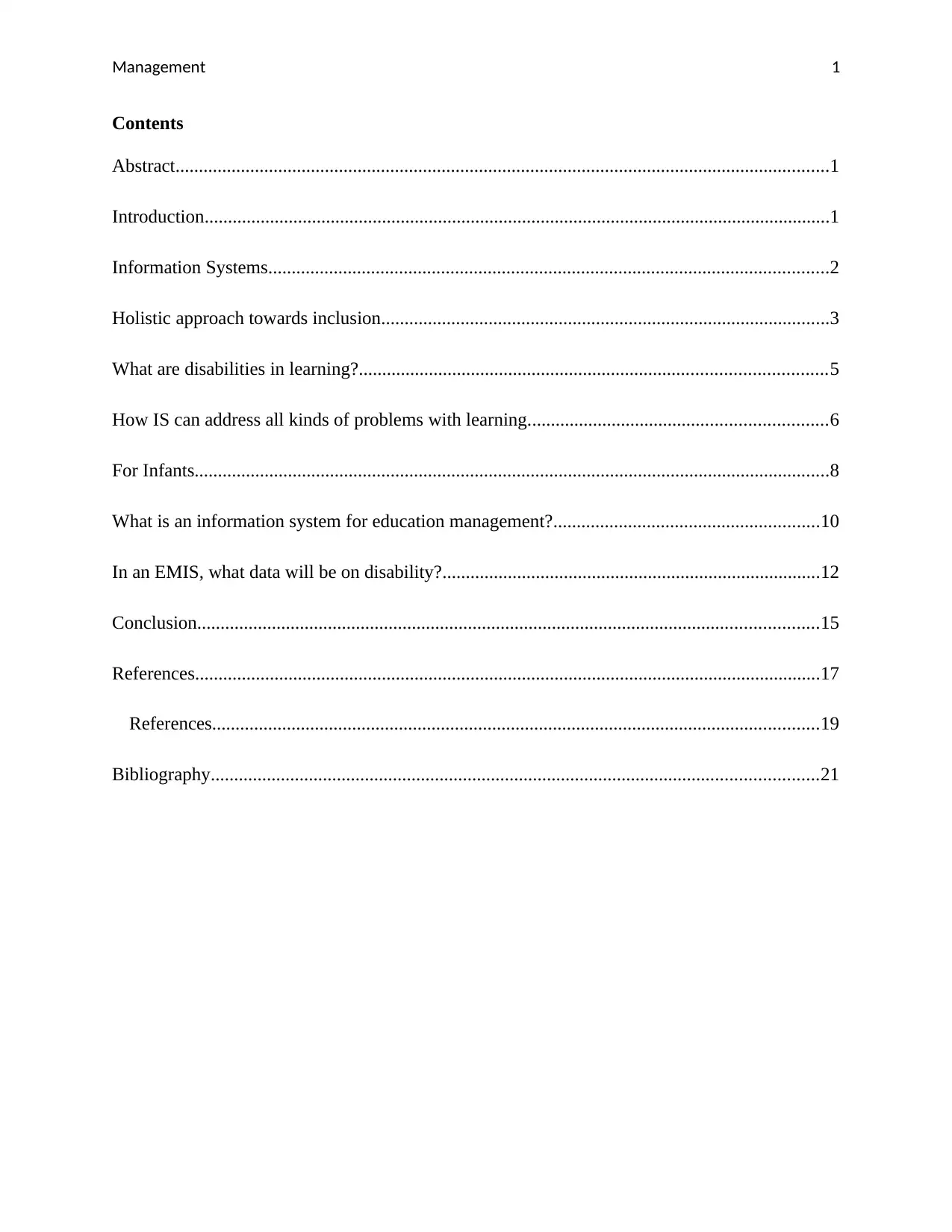
Management 1
Contents
Abstract............................................................................................................................................1
Introduction......................................................................................................................................1
Information Systems........................................................................................................................2
Holistic approach towards inclusion................................................................................................3
What are disabilities in learning?....................................................................................................5
How IS can address all kinds of problems with learning................................................................6
For Infants........................................................................................................................................8
What is an information system for education management?.........................................................10
In an EMIS, what data will be on disability?.................................................................................12
Conclusion.....................................................................................................................................15
References......................................................................................................................................17
References..................................................................................................................................19
Bibliography..................................................................................................................................21
Contents
Abstract............................................................................................................................................1
Introduction......................................................................................................................................1
Information Systems........................................................................................................................2
Holistic approach towards inclusion................................................................................................3
What are disabilities in learning?....................................................................................................5
How IS can address all kinds of problems with learning................................................................6
For Infants........................................................................................................................................8
What is an information system for education management?.........................................................10
In an EMIS, what data will be on disability?.................................................................................12
Conclusion.....................................................................................................................................15
References......................................................................................................................................17
References..................................................................................................................................19
Bibliography..................................................................................................................................21
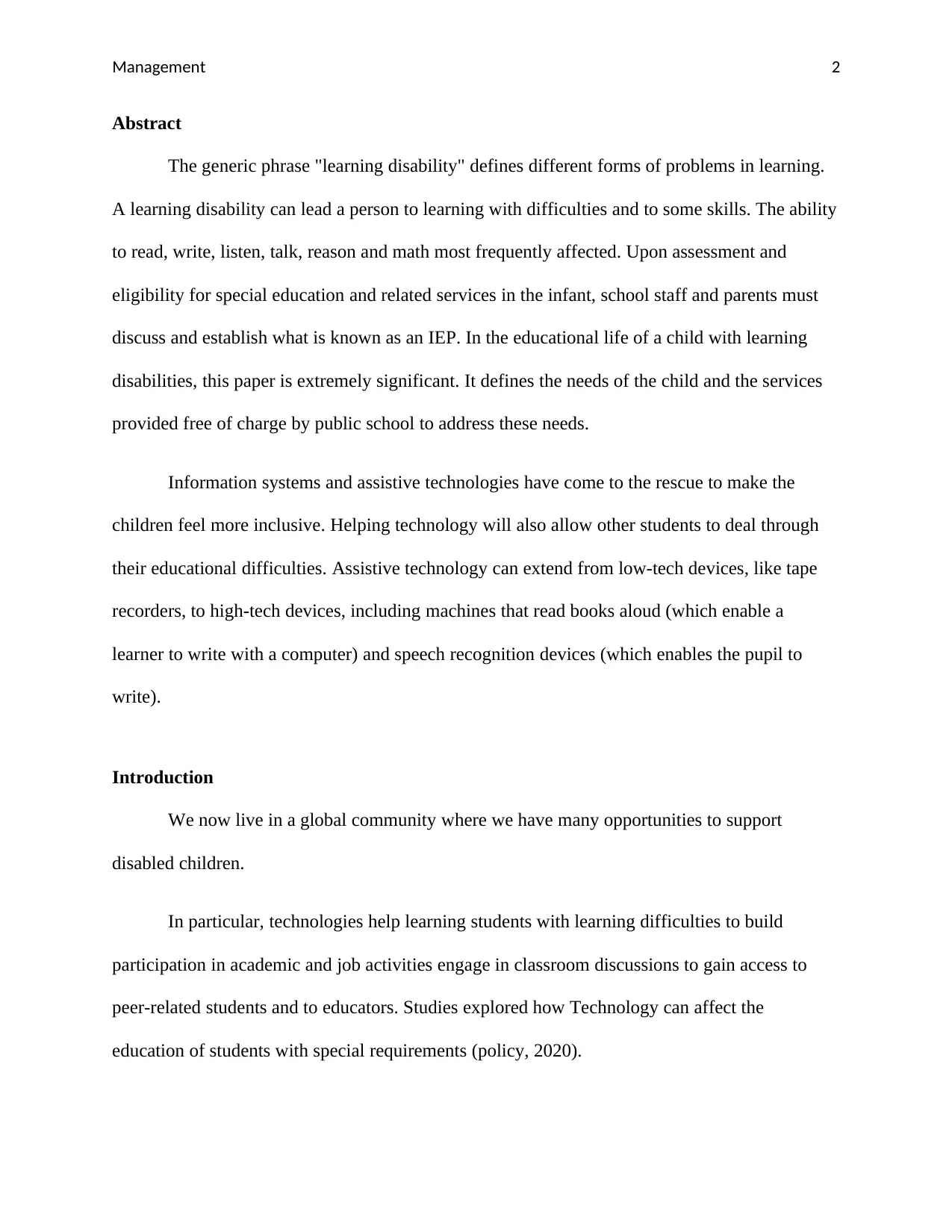
Management 2
Abstract
The generic phrase "learning disability" defines different forms of problems in learning.
A learning disability can lead a person to learning with difficulties and to some skills. The ability
to read, write, listen, talk, reason and math most frequently affected. Upon assessment and
eligibility for special education and related services in the infant, school staff and parents must
discuss and establish what is known as an IEP. In the educational life of a child with learning
disabilities, this paper is extremely significant. It defines the needs of the child and the services
provided free of charge by public school to address these needs.
Information systems and assistive technologies have come to the rescue to make the
children feel more inclusive. Helping technology will also allow other students to deal through
their educational difficulties. Assistive technology can extend from low-tech devices, like tape
recorders, to high-tech devices, including machines that read books aloud (which enable a
learner to write with a computer) and speech recognition devices (which enables the pupil to
write).
Introduction
We now live in a global community where we have many opportunities to support
disabled children.
In particular, technologies help learning students with learning difficulties to build
participation in academic and job activities engage in classroom discussions to gain access to
peer-related students and to educators. Studies explored how Technology can affect the
education of students with special requirements (policy, 2020).
Abstract
The generic phrase "learning disability" defines different forms of problems in learning.
A learning disability can lead a person to learning with difficulties and to some skills. The ability
to read, write, listen, talk, reason and math most frequently affected. Upon assessment and
eligibility for special education and related services in the infant, school staff and parents must
discuss and establish what is known as an IEP. In the educational life of a child with learning
disabilities, this paper is extremely significant. It defines the needs of the child and the services
provided free of charge by public school to address these needs.
Information systems and assistive technologies have come to the rescue to make the
children feel more inclusive. Helping technology will also allow other students to deal through
their educational difficulties. Assistive technology can extend from low-tech devices, like tape
recorders, to high-tech devices, including machines that read books aloud (which enable a
learner to write with a computer) and speech recognition devices (which enables the pupil to
write).
Introduction
We now live in a global community where we have many opportunities to support
disabled children.
In particular, technologies help learning students with learning difficulties to build
participation in academic and job activities engage in classroom discussions to gain access to
peer-related students and to educators. Studies explored how Technology can affect the
education of students with special requirements (policy, 2020).
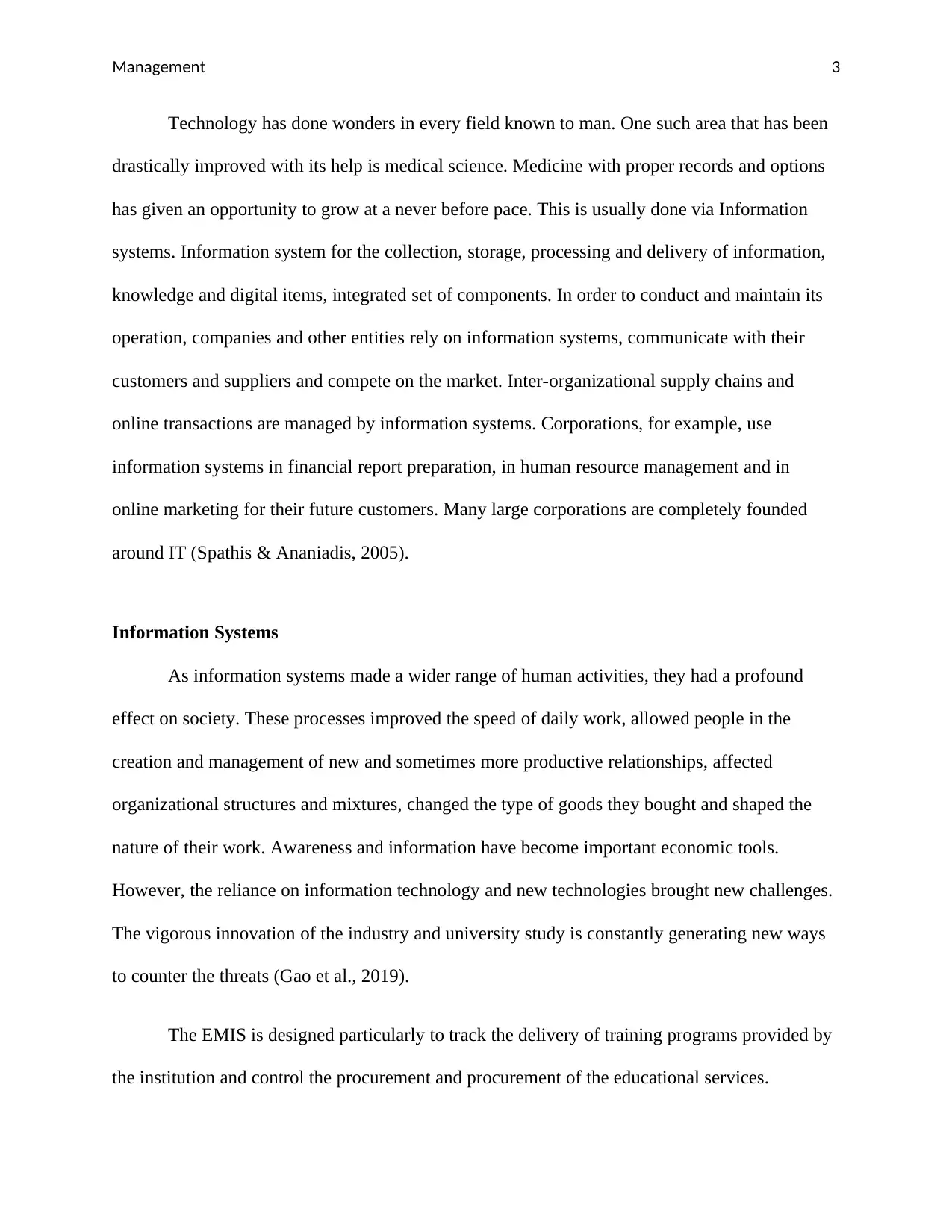
Management 3
Technology has done wonders in every field known to man. One such area that has been
drastically improved with its help is medical science. Medicine with proper records and options
has given an opportunity to grow at a never before pace. This is usually done via Information
systems. Information system for the collection, storage, processing and delivery of information,
knowledge and digital items, integrated set of components. In order to conduct and maintain its
operation, companies and other entities rely on information systems, communicate with their
customers and suppliers and compete on the market. Inter-organizational supply chains and
online transactions are managed by information systems. Corporations, for example, use
information systems in financial report preparation, in human resource management and in
online marketing for their future customers. Many large corporations are completely founded
around IT (Spathis & Ananiadis, 2005).
Information Systems
As information systems made a wider range of human activities, they had a profound
effect on society. These processes improved the speed of daily work, allowed people in the
creation and management of new and sometimes more productive relationships, affected
organizational structures and mixtures, changed the type of goods they bought and shaped the
nature of their work. Awareness and information have become important economic tools.
However, the reliance on information technology and new technologies brought new challenges.
The vigorous innovation of the industry and university study is constantly generating new ways
to counter the threats (Gao et al., 2019).
The EMIS is designed particularly to track the delivery of training programs provided by
the institution and control the procurement and procurement of the educational services.
Technology has done wonders in every field known to man. One such area that has been
drastically improved with its help is medical science. Medicine with proper records and options
has given an opportunity to grow at a never before pace. This is usually done via Information
systems. Information system for the collection, storage, processing and delivery of information,
knowledge and digital items, integrated set of components. In order to conduct and maintain its
operation, companies and other entities rely on information systems, communicate with their
customers and suppliers and compete on the market. Inter-organizational supply chains and
online transactions are managed by information systems. Corporations, for example, use
information systems in financial report preparation, in human resource management and in
online marketing for their future customers. Many large corporations are completely founded
around IT (Spathis & Ananiadis, 2005).
Information Systems
As information systems made a wider range of human activities, they had a profound
effect on society. These processes improved the speed of daily work, allowed people in the
creation and management of new and sometimes more productive relationships, affected
organizational structures and mixtures, changed the type of goods they bought and shaped the
nature of their work. Awareness and information have become important economic tools.
However, the reliance on information technology and new technologies brought new challenges.
The vigorous innovation of the industry and university study is constantly generating new ways
to counter the threats (Gao et al., 2019).
The EMIS is designed particularly to track the delivery of training programs provided by
the institution and control the procurement and procurement of the educational services.
Secure Best Marks with AI Grader
Need help grading? Try our AI Grader for instant feedback on your assignments.

Management 4
Education Management Information System (EMIS) Naturally, EMIS has unique functions to
promote the growth of a school in the field of education (Raunch, 2020).
Holistic approach towards inclusion
Many higher education institutions already plan to adopt a holistic management approach
for education that can complement learning processes and enhance the experience of students.
While higher education has been covered a huge area that needs attention is Infants and toddlers
with Learning disability. Such kids need to be included, always in a group setting. They should
not be made to feel that they are different and should be included. Inclusion initially requires a
mechanism to recognize and to act to build inclusive childcare environments. The attitude of
acceptance and compassion and a determination to build an environment of true belonging for
children and their families is required for child care and infant healthcare (Mason, 2019).
Infants and kids may also benefit tremendously from assistive technology services, but
they may not have the ability to use a keyboard or computer. Resent research shows that babies
and kids do not have to learn the use of such equipment until they benefit. For example, many
kids will learn to interact effectively and meet milestones they wouldn't have been able to
achieve otherwise by using a touchscreen tablet.
Amplifying communication tools may allow children who have limited language and
difficulties with oral communication to learn to communicate more effectively. In addition,
babies and children will use more complicated devices as they grow older with the early
implementation of technical technologies.
Education Management Information System (EMIS) Naturally, EMIS has unique functions to
promote the growth of a school in the field of education (Raunch, 2020).
Holistic approach towards inclusion
Many higher education institutions already plan to adopt a holistic management approach
for education that can complement learning processes and enhance the experience of students.
While higher education has been covered a huge area that needs attention is Infants and toddlers
with Learning disability. Such kids need to be included, always in a group setting. They should
not be made to feel that they are different and should be included. Inclusion initially requires a
mechanism to recognize and to act to build inclusive childcare environments. The attitude of
acceptance and compassion and a determination to build an environment of true belonging for
children and their families is required for child care and infant healthcare (Mason, 2019).
Infants and kids may also benefit tremendously from assistive technology services, but
they may not have the ability to use a keyboard or computer. Resent research shows that babies
and kids do not have to learn the use of such equipment until they benefit. For example, many
kids will learn to interact effectively and meet milestones they wouldn't have been able to
achieve otherwise by using a touchscreen tablet.
Amplifying communication tools may allow children who have limited language and
difficulties with oral communication to learn to communicate more effectively. In addition,
babies and children will use more complicated devices as they grow older with the early
implementation of technical technologies.

Management 5
Babies and children will physically benefit from a variety of tools to help them crawl, sit,
walk and explore.
Through childhood, many lifelong skills are established. Nevertheless, it is more difficult
for young children to develop vital skills. AT items and services will help close the gap and
enable babies to learn the same skills as non-disabled babies (Adam, 2020).
Every of us knows the need to feel and to belong. This is the essence of inclusive
childcare, where every mom, infant and adolescent feels like a leading member.
These things can be done if a parent/guardian is able to identify that their child needs
special care. Identification is tough, but one way to do this is to keep track of their
developmental milestones and the other is to contact you nearest centre (Singleton, Horne &
Simmons, 2009).
Tools in Texas
In Texas, for toddlers and infants with learning disabilities, there are various centres like
Children’s Disabilities Information Coalition – CPRC, PEN Project – PTI, PATH Project – PTI,
Team Project, Partners Resource Network, Inc. – PTI.
Some online sources for finding great assistive technology. match children to the right
assistive devices or technology (America, America, America & America, 2020).
Texas Technology Access Project is a program through the University of Texas at Austin.
They loan out devices and offer low-interest loans to purchase assistive technology.
The Center on Technology and Disability helps connect families to the right assistive
technology.
Babies and children will physically benefit from a variety of tools to help them crawl, sit,
walk and explore.
Through childhood, many lifelong skills are established. Nevertheless, it is more difficult
for young children to develop vital skills. AT items and services will help close the gap and
enable babies to learn the same skills as non-disabled babies (Adam, 2020).
Every of us knows the need to feel and to belong. This is the essence of inclusive
childcare, where every mom, infant and adolescent feels like a leading member.
These things can be done if a parent/guardian is able to identify that their child needs
special care. Identification is tough, but one way to do this is to keep track of their
developmental milestones and the other is to contact you nearest centre (Singleton, Horne &
Simmons, 2009).
Tools in Texas
In Texas, for toddlers and infants with learning disabilities, there are various centres like
Children’s Disabilities Information Coalition – CPRC, PEN Project – PTI, PATH Project – PTI,
Team Project, Partners Resource Network, Inc. – PTI.
Some online sources for finding great assistive technology. match children to the right
assistive devices or technology (America, America, America & America, 2020).
Texas Technology Access Project is a program through the University of Texas at Austin.
They loan out devices and offer low-interest loans to purchase assistive technology.
The Center on Technology and Disability helps connect families to the right assistive
technology.
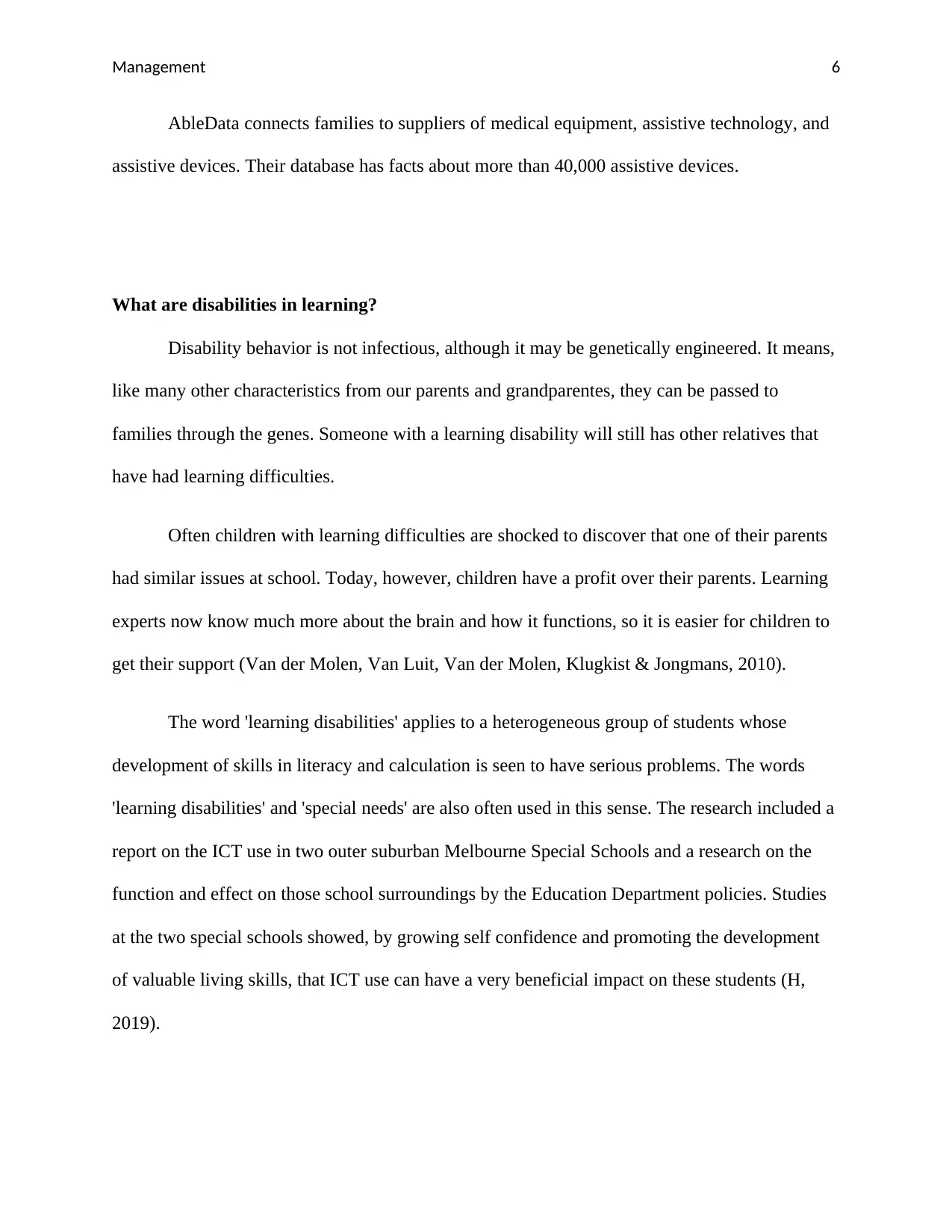
Management 6
AbleData connects families to suppliers of medical equipment, assistive technology, and
assistive devices. Their database has facts about more than 40,000 assistive devices.
What are disabilities in learning?
Disability behavior is not infectious, although it may be genetically engineered. It means,
like many other characteristics from our parents and grandparentes, they can be passed to
families through the genes. Someone with a learning disability will still has other relatives that
have had learning difficulties.
Often children with learning difficulties are shocked to discover that one of their parents
had similar issues at school. Today, however, children have a profit over their parents. Learning
experts now know much more about the brain and how it functions, so it is easier for children to
get their support (Van der Molen, Van Luit, Van der Molen, Klugkist & Jongmans, 2010).
The word 'learning disabilities' applies to a heterogeneous group of students whose
development of skills in literacy and calculation is seen to have serious problems. The words
'learning disabilities' and 'special needs' are also often used in this sense. The research included a
report on the ICT use in two outer suburban Melbourne Special Schools and a research on the
function and effect on those school surroundings by the Education Department policies. Studies
at the two special schools showed, by growing self confidence and promoting the development
of valuable living skills, that ICT use can have a very beneficial impact on these students (H,
2019).
AbleData connects families to suppliers of medical equipment, assistive technology, and
assistive devices. Their database has facts about more than 40,000 assistive devices.
What are disabilities in learning?
Disability behavior is not infectious, although it may be genetically engineered. It means,
like many other characteristics from our parents and grandparentes, they can be passed to
families through the genes. Someone with a learning disability will still has other relatives that
have had learning difficulties.
Often children with learning difficulties are shocked to discover that one of their parents
had similar issues at school. Today, however, children have a profit over their parents. Learning
experts now know much more about the brain and how it functions, so it is easier for children to
get their support (Van der Molen, Van Luit, Van der Molen, Klugkist & Jongmans, 2010).
The word 'learning disabilities' applies to a heterogeneous group of students whose
development of skills in literacy and calculation is seen to have serious problems. The words
'learning disabilities' and 'special needs' are also often used in this sense. The research included a
report on the ICT use in two outer suburban Melbourne Special Schools and a research on the
function and effect on those school surroundings by the Education Department policies. Studies
at the two special schools showed, by growing self confidence and promoting the development
of valuable living skills, that ICT use can have a very beneficial impact on these students (H,
2019).
Paraphrase This Document
Need a fresh take? Get an instant paraphrase of this document with our AI Paraphraser
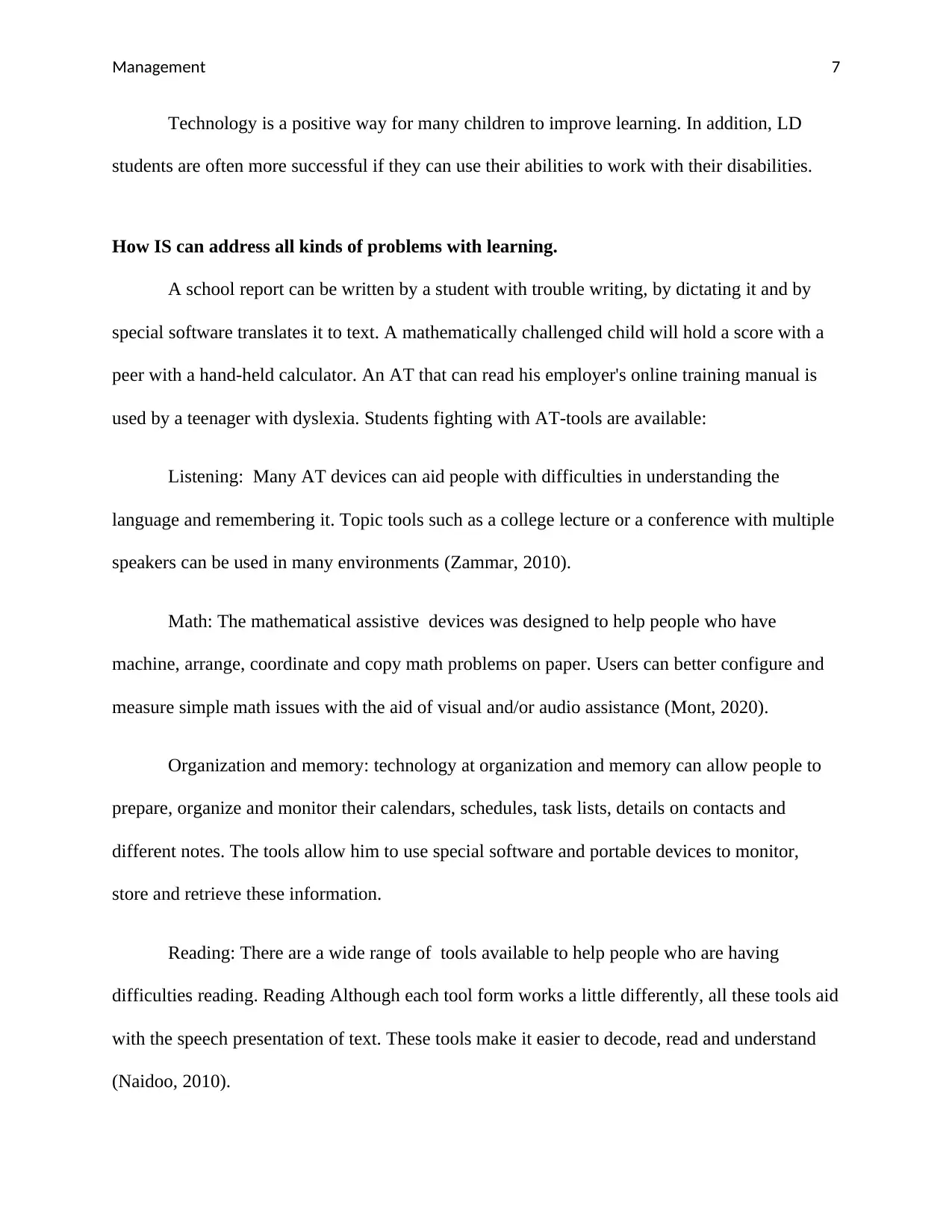
Management 7
Technology is a positive way for many children to improve learning. In addition, LD
students are often more successful if they can use their abilities to work with their disabilities.
How IS can address all kinds of problems with learning.
A school report can be written by a student with trouble writing, by dictating it and by
special software translates it to text. A mathematically challenged child will hold a score with a
peer with a hand-held calculator. An AT that can read his employer's online training manual is
used by a teenager with dyslexia. Students fighting with AT-tools are available:
Listening: Many AT devices can aid people with difficulties in understanding the
language and remembering it. Topic tools such as a college lecture or a conference with multiple
speakers can be used in many environments (Zammar, 2010).
Math: The mathematical assistive devices was designed to help people who have
machine, arrange, coordinate and copy math problems on paper. Users can better configure and
measure simple math issues with the aid of visual and/or audio assistance (Mont, 2020).
Organization and memory: technology at organization and memory can allow people to
prepare, organize and monitor their calendars, schedules, task lists, details on contacts and
different notes. The tools allow him to use special software and portable devices to monitor,
store and retrieve these information.
Reading: There are a wide range of tools available to help people who are having
difficulties reading. Reading Although each tool form works a little differently, all these tools aid
with the speech presentation of text. These tools make it easier to decode, read and understand
(Naidoo, 2010).
Technology is a positive way for many children to improve learning. In addition, LD
students are often more successful if they can use their abilities to work with their disabilities.
How IS can address all kinds of problems with learning.
A school report can be written by a student with trouble writing, by dictating it and by
special software translates it to text. A mathematically challenged child will hold a score with a
peer with a hand-held calculator. An AT that can read his employer's online training manual is
used by a teenager with dyslexia. Students fighting with AT-tools are available:
Listening: Many AT devices can aid people with difficulties in understanding the
language and remembering it. Topic tools such as a college lecture or a conference with multiple
speakers can be used in many environments (Zammar, 2010).
Math: The mathematical assistive devices was designed to help people who have
machine, arrange, coordinate and copy math problems on paper. Users can better configure and
measure simple math issues with the aid of visual and/or audio assistance (Mont, 2020).
Organization and memory: technology at organization and memory can allow people to
prepare, organize and monitor their calendars, schedules, task lists, details on contacts and
different notes. The tools allow him to use special software and portable devices to monitor,
store and retrieve these information.
Reading: There are a wide range of tools available to help people who are having
difficulties reading. Reading Although each tool form works a little differently, all these tools aid
with the speech presentation of text. These tools make it easier to decode, read and understand
(Naidoo, 2010).
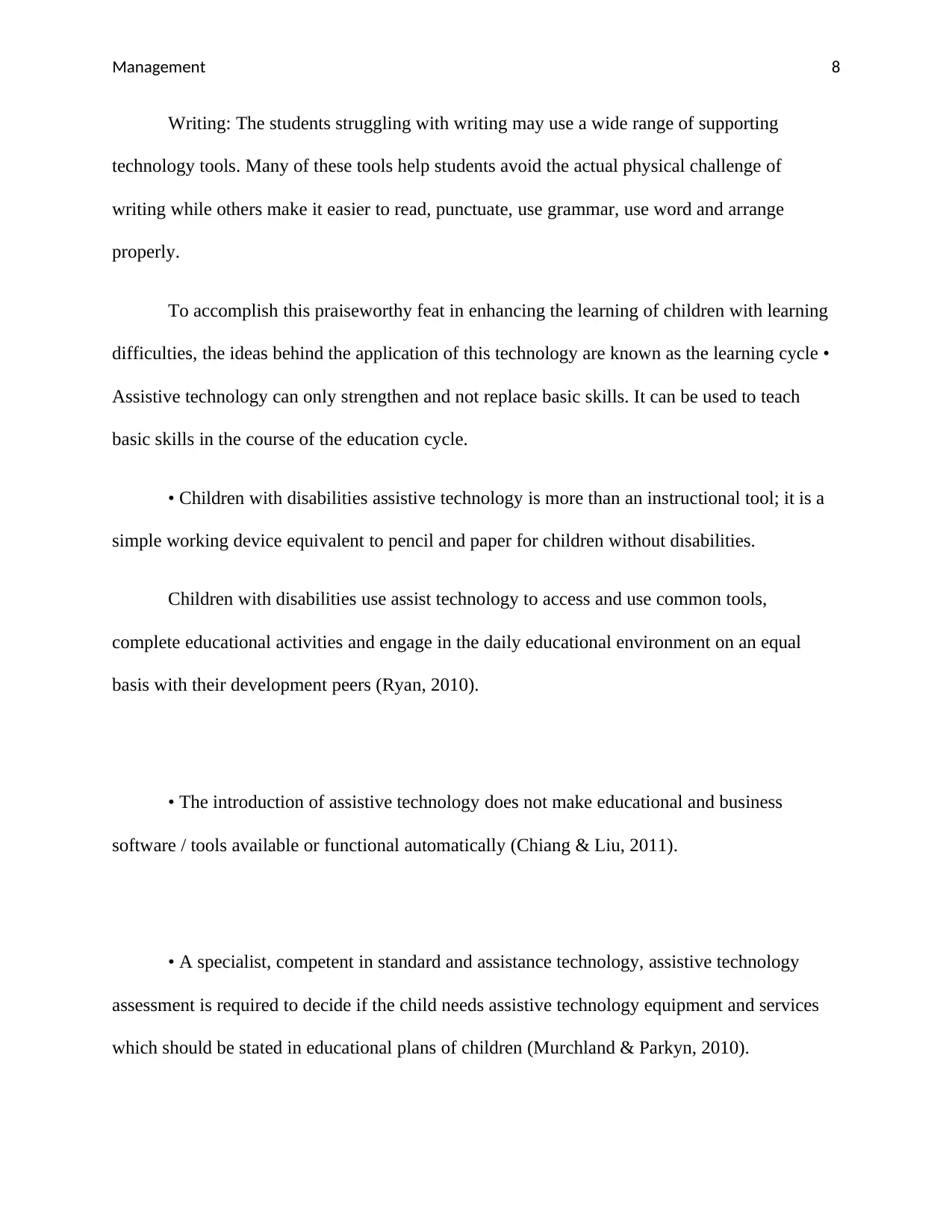
Management 8
Writing: The students struggling with writing may use a wide range of supporting
technology tools. Many of these tools help students avoid the actual physical challenge of
writing while others make it easier to read, punctuate, use grammar, use word and arrange
properly.
To accomplish this praiseworthy feat in enhancing the learning of children with learning
difficulties, the ideas behind the application of this technology are known as the learning cycle •
Assistive technology can only strengthen and not replace basic skills. It can be used to teach
basic skills in the course of the education cycle.
• Children with disabilities assistive technology is more than an instructional tool; it is a
simple working device equivalent to pencil and paper for children without disabilities.
Children with disabilities use assist technology to access and use common tools,
complete educational activities and engage in the daily educational environment on an equal
basis with their development peers (Ryan, 2010).
• The introduction of assistive technology does not make educational and business
software / tools available or functional automatically (Chiang & Liu, 2011).
• A specialist, competent in standard and assistance technology, assistive technology
assessment is required to decide if the child needs assistive technology equipment and services
which should be stated in educational plans of children (Murchland & Parkyn, 2010).
Writing: The students struggling with writing may use a wide range of supporting
technology tools. Many of these tools help students avoid the actual physical challenge of
writing while others make it easier to read, punctuate, use grammar, use word and arrange
properly.
To accomplish this praiseworthy feat in enhancing the learning of children with learning
difficulties, the ideas behind the application of this technology are known as the learning cycle •
Assistive technology can only strengthen and not replace basic skills. It can be used to teach
basic skills in the course of the education cycle.
• Children with disabilities assistive technology is more than an instructional tool; it is a
simple working device equivalent to pencil and paper for children without disabilities.
Children with disabilities use assist technology to access and use common tools,
complete educational activities and engage in the daily educational environment on an equal
basis with their development peers (Ryan, 2010).
• The introduction of assistive technology does not make educational and business
software / tools available or functional automatically (Chiang & Liu, 2011).
• A specialist, competent in standard and assistance technology, assistive technology
assessment is required to decide if the child needs assistive technology equipment and services
which should be stated in educational plans of children (Murchland & Parkyn, 2010).
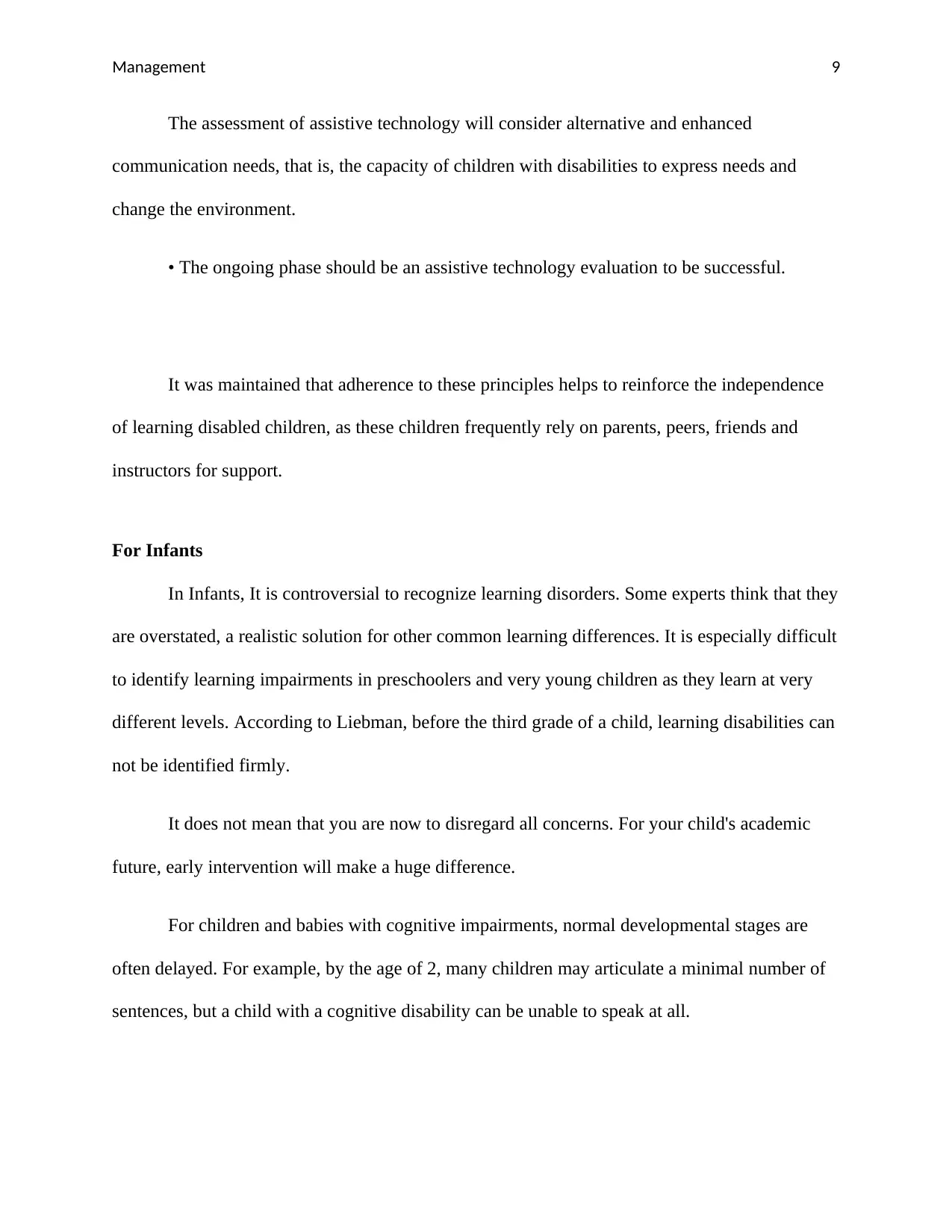
Management 9
The assessment of assistive technology will consider alternative and enhanced
communication needs, that is, the capacity of children with disabilities to express needs and
change the environment.
• The ongoing phase should be an assistive technology evaluation to be successful.
It was maintained that adherence to these principles helps to reinforce the independence
of learning disabled children, as these children frequently rely on parents, peers, friends and
instructors for support.
For Infants
In Infants, It is controversial to recognize learning disorders. Some experts think that they
are overstated, a realistic solution for other common learning differences. It is especially difficult
to identify learning impairments in preschoolers and very young children as they learn at very
different levels. According to Liebman, before the third grade of a child, learning disabilities can
not be identified firmly.
It does not mean that you are now to disregard all concerns. For your child's academic
future, early intervention will make a huge difference.
For children and babies with cognitive impairments, normal developmental stages are
often delayed. For example, by the age of 2, many children may articulate a minimal number of
sentences, but a child with a cognitive disability can be unable to speak at all.
The assessment of assistive technology will consider alternative and enhanced
communication needs, that is, the capacity of children with disabilities to express needs and
change the environment.
• The ongoing phase should be an assistive technology evaluation to be successful.
It was maintained that adherence to these principles helps to reinforce the independence
of learning disabled children, as these children frequently rely on parents, peers, friends and
instructors for support.
For Infants
In Infants, It is controversial to recognize learning disorders. Some experts think that they
are overstated, a realistic solution for other common learning differences. It is especially difficult
to identify learning impairments in preschoolers and very young children as they learn at very
different levels. According to Liebman, before the third grade of a child, learning disabilities can
not be identified firmly.
It does not mean that you are now to disregard all concerns. For your child's academic
future, early intervention will make a huge difference.
For children and babies with cognitive impairments, normal developmental stages are
often delayed. For example, by the age of 2, many children may articulate a minimal number of
sentences, but a child with a cognitive disability can be unable to speak at all.
Secure Best Marks with AI Grader
Need help grading? Try our AI Grader for instant feedback on your assignments.
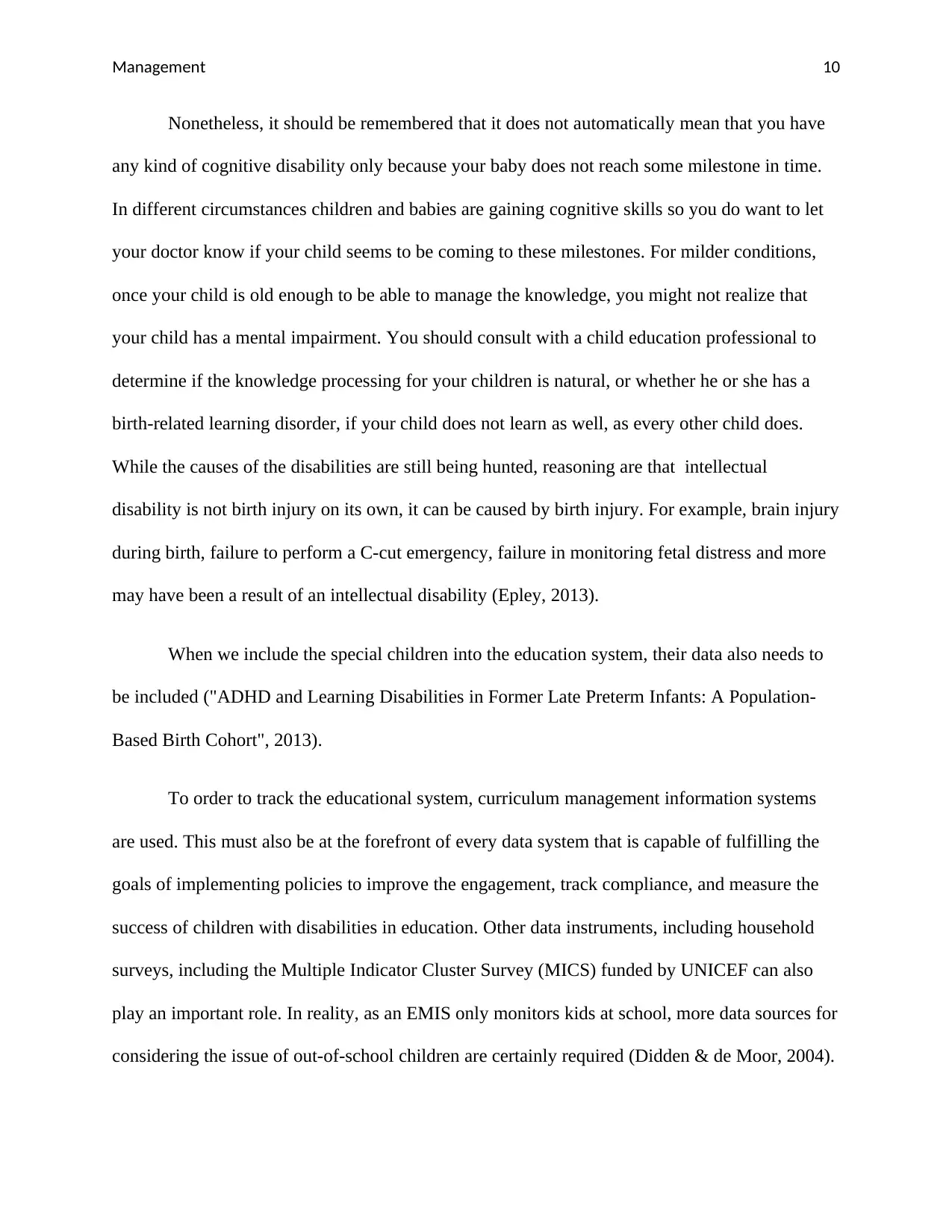
Management 10
Nonetheless, it should be remembered that it does not automatically mean that you have
any kind of cognitive disability only because your baby does not reach some milestone in time.
In different circumstances children and babies are gaining cognitive skills so you do want to let
your doctor know if your child seems to be coming to these milestones. For milder conditions,
once your child is old enough to be able to manage the knowledge, you might not realize that
your child has a mental impairment. You should consult with a child education professional to
determine if the knowledge processing for your children is natural, or whether he or she has a
birth-related learning disorder, if your child does not learn as well, as every other child does.
While the causes of the disabilities are still being hunted, reasoning are that intellectual
disability is not birth injury on its own, it can be caused by birth injury. For example, brain injury
during birth, failure to perform a C-cut emergency, failure in monitoring fetal distress and more
may have been a result of an intellectual disability (Epley, 2013).
When we include the special children into the education system, their data also needs to
be included ("ADHD and Learning Disabilities in Former Late Preterm Infants: A Population-
Based Birth Cohort", 2013).
To order to track the educational system, curriculum management information systems
are used. This must also be at the forefront of every data system that is capable of fulfilling the
goals of implementing policies to improve the engagement, track compliance, and measure the
success of children with disabilities in education. Other data instruments, including household
surveys, including the Multiple Indicator Cluster Survey (MICS) funded by UNICEF can also
play an important role. In reality, as an EMIS only monitors kids at school, more data sources for
considering the issue of out-of-school children are certainly required (Didden & de Moor, 2004).
Nonetheless, it should be remembered that it does not automatically mean that you have
any kind of cognitive disability only because your baby does not reach some milestone in time.
In different circumstances children and babies are gaining cognitive skills so you do want to let
your doctor know if your child seems to be coming to these milestones. For milder conditions,
once your child is old enough to be able to manage the knowledge, you might not realize that
your child has a mental impairment. You should consult with a child education professional to
determine if the knowledge processing for your children is natural, or whether he or she has a
birth-related learning disorder, if your child does not learn as well, as every other child does.
While the causes of the disabilities are still being hunted, reasoning are that intellectual
disability is not birth injury on its own, it can be caused by birth injury. For example, brain injury
during birth, failure to perform a C-cut emergency, failure in monitoring fetal distress and more
may have been a result of an intellectual disability (Epley, 2013).
When we include the special children into the education system, their data also needs to
be included ("ADHD and Learning Disabilities in Former Late Preterm Infants: A Population-
Based Birth Cohort", 2013).
To order to track the educational system, curriculum management information systems
are used. This must also be at the forefront of every data system that is capable of fulfilling the
goals of implementing policies to improve the engagement, track compliance, and measure the
success of children with disabilities in education. Other data instruments, including household
surveys, including the Multiple Indicator Cluster Survey (MICS) funded by UNICEF can also
play an important role. In reality, as an EMIS only monitors kids at school, more data sources for
considering the issue of out-of-school children are certainly required (Didden & de Moor, 2004).
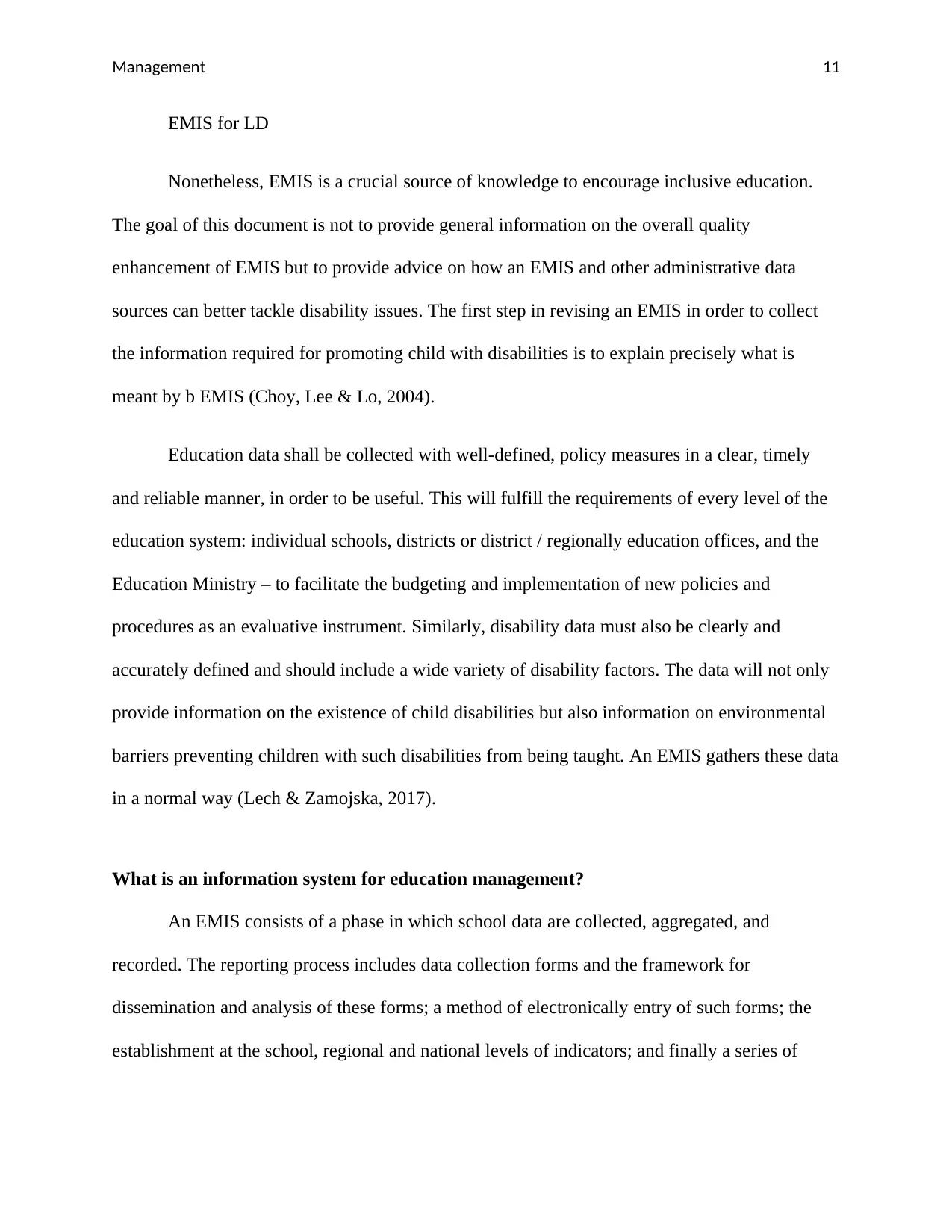
Management 11
EMIS for LD
Nonetheless, EMIS is a crucial source of knowledge to encourage inclusive education.
The goal of this document is not to provide general information on the overall quality
enhancement of EMIS but to provide advice on how an EMIS and other administrative data
sources can better tackle disability issues. The first step in revising an EMIS in order to collect
the information required for promoting child with disabilities is to explain precisely what is
meant by b EMIS (Choy, Lee & Lo, 2004).
Education data shall be collected with well-defined, policy measures in a clear, timely
and reliable manner, in order to be useful. This will fulfill the requirements of every level of the
education system: individual schools, districts or district / regionally education offices, and the
Education Ministry – to facilitate the budgeting and implementation of new policies and
procedures as an evaluative instrument. Similarly, disability data must also be clearly and
accurately defined and should include a wide variety of disability factors. The data will not only
provide information on the existence of child disabilities but also information on environmental
barriers preventing children with such disabilities from being taught. An EMIS gathers these data
in a normal way (Lech & Zamojska, 2017).
What is an information system for education management?
An EMIS consists of a phase in which school data are collected, aggregated, and
recorded. The reporting process includes data collection forms and the framework for
dissemination and analysis of these forms; a method of electronically entry of such forms; the
establishment at the school, regional and national levels of indicators; and finally a series of
EMIS for LD
Nonetheless, EMIS is a crucial source of knowledge to encourage inclusive education.
The goal of this document is not to provide general information on the overall quality
enhancement of EMIS but to provide advice on how an EMIS and other administrative data
sources can better tackle disability issues. The first step in revising an EMIS in order to collect
the information required for promoting child with disabilities is to explain precisely what is
meant by b EMIS (Choy, Lee & Lo, 2004).
Education data shall be collected with well-defined, policy measures in a clear, timely
and reliable manner, in order to be useful. This will fulfill the requirements of every level of the
education system: individual schools, districts or district / regionally education offices, and the
Education Ministry – to facilitate the budgeting and implementation of new policies and
procedures as an evaluative instrument. Similarly, disability data must also be clearly and
accurately defined and should include a wide variety of disability factors. The data will not only
provide information on the existence of child disabilities but also information on environmental
barriers preventing children with such disabilities from being taught. An EMIS gathers these data
in a normal way (Lech & Zamojska, 2017).
What is an information system for education management?
An EMIS consists of a phase in which school data are collected, aggregated, and
recorded. The reporting process includes data collection forms and the framework for
dissemination and analysis of these forms; a method of electronically entry of such forms; the
establishment at the school, regional and national levels of indicators; and finally a series of
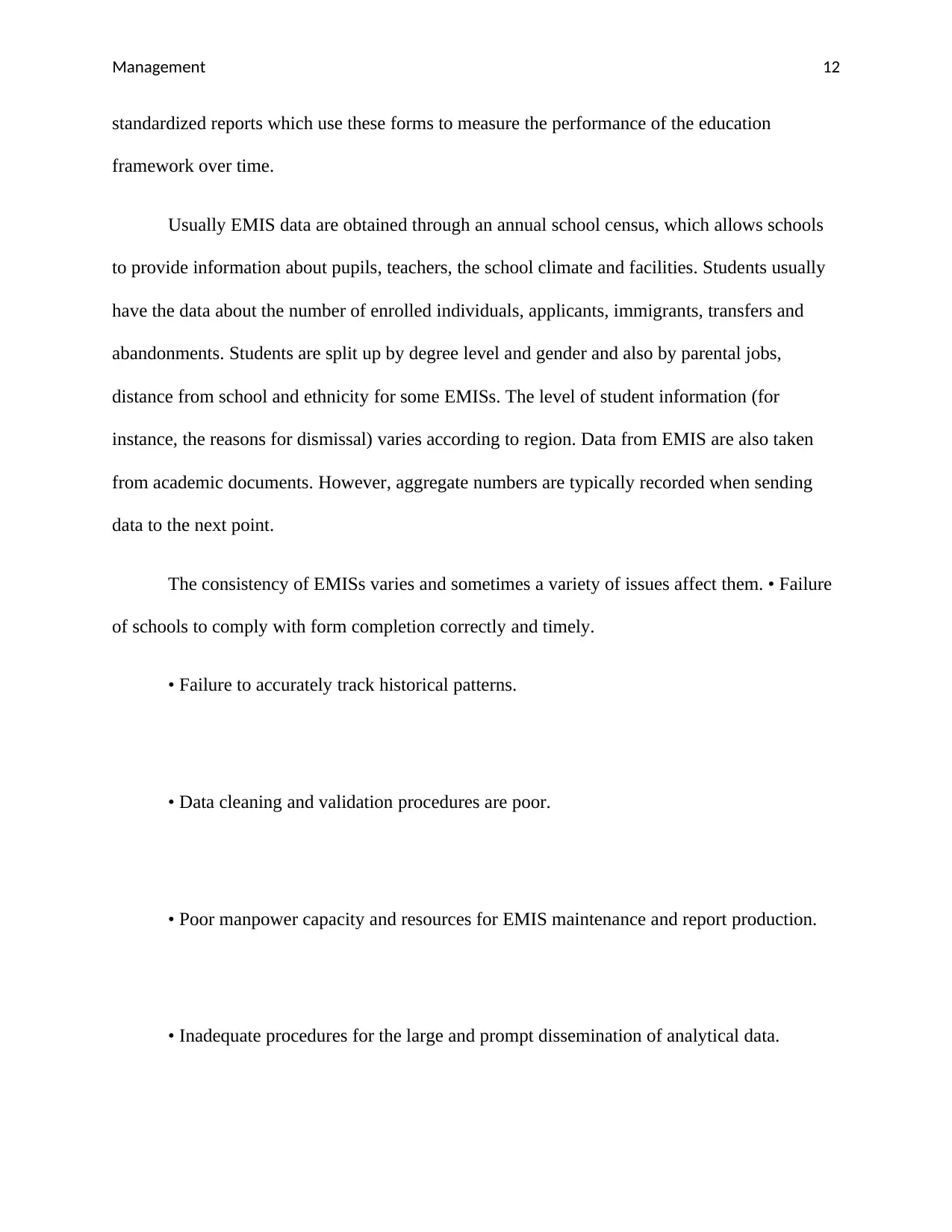
Management 12
standardized reports which use these forms to measure the performance of the education
framework over time.
Usually EMIS data are obtained through an annual school census, which allows schools
to provide information about pupils, teachers, the school climate and facilities. Students usually
have the data about the number of enrolled individuals, applicants, immigrants, transfers and
abandonments. Students are split up by degree level and gender and also by parental jobs,
distance from school and ethnicity for some EMISs. The level of student information (for
instance, the reasons for dismissal) varies according to region. Data from EMIS are also taken
from academic documents. However, aggregate numbers are typically recorded when sending
data to the next point.
The consistency of EMISs varies and sometimes a variety of issues affect them. • Failure
of schools to comply with form completion correctly and timely.
• Failure to accurately track historical patterns.
• Data cleaning and validation procedures are poor.
• Poor manpower capacity and resources for EMIS maintenance and report production.
• Inadequate procedures for the large and prompt dissemination of analytical data.
standardized reports which use these forms to measure the performance of the education
framework over time.
Usually EMIS data are obtained through an annual school census, which allows schools
to provide information about pupils, teachers, the school climate and facilities. Students usually
have the data about the number of enrolled individuals, applicants, immigrants, transfers and
abandonments. Students are split up by degree level and gender and also by parental jobs,
distance from school and ethnicity for some EMISs. The level of student information (for
instance, the reasons for dismissal) varies according to region. Data from EMIS are also taken
from academic documents. However, aggregate numbers are typically recorded when sending
data to the next point.
The consistency of EMISs varies and sometimes a variety of issues affect them. • Failure
of schools to comply with form completion correctly and timely.
• Failure to accurately track historical patterns.
• Data cleaning and validation procedures are poor.
• Poor manpower capacity and resources for EMIS maintenance and report production.
• Inadequate procedures for the large and prompt dissemination of analytical data.
Paraphrase This Document
Need a fresh take? Get an instant paraphrase of this document with our AI Paraphraser

Management 13
It is important to bear in mind that an EMIS gathers only information about children
engaging with the education system. During the absence of school enrolment for children with
disabilities, they will not be covered by EMIS. Therefore, while an EMIS can be a valuable way
of tracking school attendance and progress and exposure to the school environment, it cannot
deal with the issue of the registration rate of children with disabilities or the reasons for their
failure to register. For this reason, a household survey with a disability module – for example a
multiple indicator cluster survey – is appropriate
In an EMIS, what data will be on disability?
In order for article 24 of the CDPH (Convention on the Rights of Persons with
Disabilities) to be effectively enforced, high quality data is required which is useful for the
formulation and follow up of policies and their implementation. These statistics come in different
categories:
Kids with disabilities recognition., these include 'those suffering from long-term physical,
emotional, intellectual, or sensory impairments who may impair their complete and successful
participation in society on an equal footing with others by engaging with various barriers.'
Barriers to learning in space and materials. Those include physical access to school
buildings and include the use of furniture, facilities, learning resources and communication
services for the distribution of information (e.g. Braille and audio books, signage).
Resources and Facilities for Human Capital. It covers the education of teachers, their
access to teaching support resources and educational services for students. Such programs can
include such items as voice, physical and occupational therapy or classroom support (Hattier,
Matson, Sipes & Turygin, 2011).
It is important to bear in mind that an EMIS gathers only information about children
engaging with the education system. During the absence of school enrolment for children with
disabilities, they will not be covered by EMIS. Therefore, while an EMIS can be a valuable way
of tracking school attendance and progress and exposure to the school environment, it cannot
deal with the issue of the registration rate of children with disabilities or the reasons for their
failure to register. For this reason, a household survey with a disability module – for example a
multiple indicator cluster survey – is appropriate
In an EMIS, what data will be on disability?
In order for article 24 of the CDPH (Convention on the Rights of Persons with
Disabilities) to be effectively enforced, high quality data is required which is useful for the
formulation and follow up of policies and their implementation. These statistics come in different
categories:
Kids with disabilities recognition., these include 'those suffering from long-term physical,
emotional, intellectual, or sensory impairments who may impair their complete and successful
participation in society on an equal footing with others by engaging with various barriers.'
Barriers to learning in space and materials. Those include physical access to school
buildings and include the use of furniture, facilities, learning resources and communication
services for the distribution of information (e.g. Braille and audio books, signage).
Resources and Facilities for Human Capital. It covers the education of teachers, their
access to teaching support resources and educational services for students. Such programs can
include such items as voice, physical and occupational therapy or classroom support (Hattier,
Matson, Sipes & Turygin, 2011).
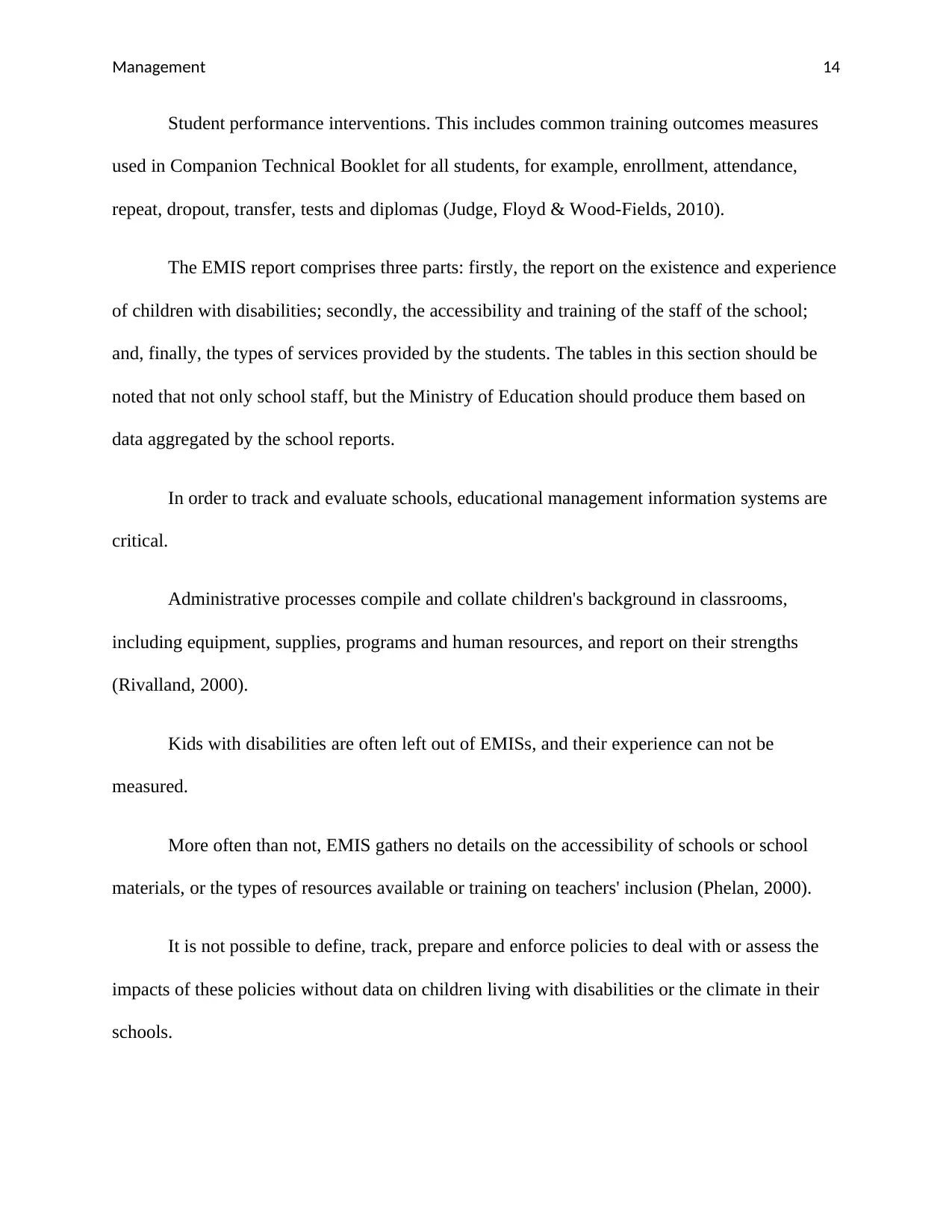
Management 14
Student performance interventions. This includes common training outcomes measures
used in Companion Technical Booklet for all students, for example, enrollment, attendance,
repeat, dropout, transfer, tests and diplomas (Judge, Floyd & Wood-Fields, 2010).
The EMIS report comprises three parts: firstly, the report on the existence and experience
of children with disabilities; secondly, the accessibility and training of the staff of the school;
and, finally, the types of services provided by the students. The tables in this section should be
noted that not only school staff, but the Ministry of Education should produce them based on
data aggregated by the school reports.
In order to track and evaluate schools, educational management information systems are
critical.
Administrative processes compile and collate children's background in classrooms,
including equipment, supplies, programs and human resources, and report on their strengths
(Rivalland, 2000).
Kids with disabilities are often left out of EMISs, and their experience can not be
measured.
More often than not, EMIS gathers no details on the accessibility of schools or school
materials, or the types of resources available or training on teachers' inclusion (Phelan, 2000).
It is not possible to define, track, prepare and enforce policies to deal with or assess the
impacts of these policies without data on children living with disabilities or the climate in their
schools.
Student performance interventions. This includes common training outcomes measures
used in Companion Technical Booklet for all students, for example, enrollment, attendance,
repeat, dropout, transfer, tests and diplomas (Judge, Floyd & Wood-Fields, 2010).
The EMIS report comprises three parts: firstly, the report on the existence and experience
of children with disabilities; secondly, the accessibility and training of the staff of the school;
and, finally, the types of services provided by the students. The tables in this section should be
noted that not only school staff, but the Ministry of Education should produce them based on
data aggregated by the school reports.
In order to track and evaluate schools, educational management information systems are
critical.
Administrative processes compile and collate children's background in classrooms,
including equipment, supplies, programs and human resources, and report on their strengths
(Rivalland, 2000).
Kids with disabilities are often left out of EMISs, and their experience can not be
measured.
More often than not, EMIS gathers no details on the accessibility of schools or school
materials, or the types of resources available or training on teachers' inclusion (Phelan, 2000).
It is not possible to define, track, prepare and enforce policies to deal with or assess the
impacts of these policies without data on children living with disabilities or the climate in their
schools.
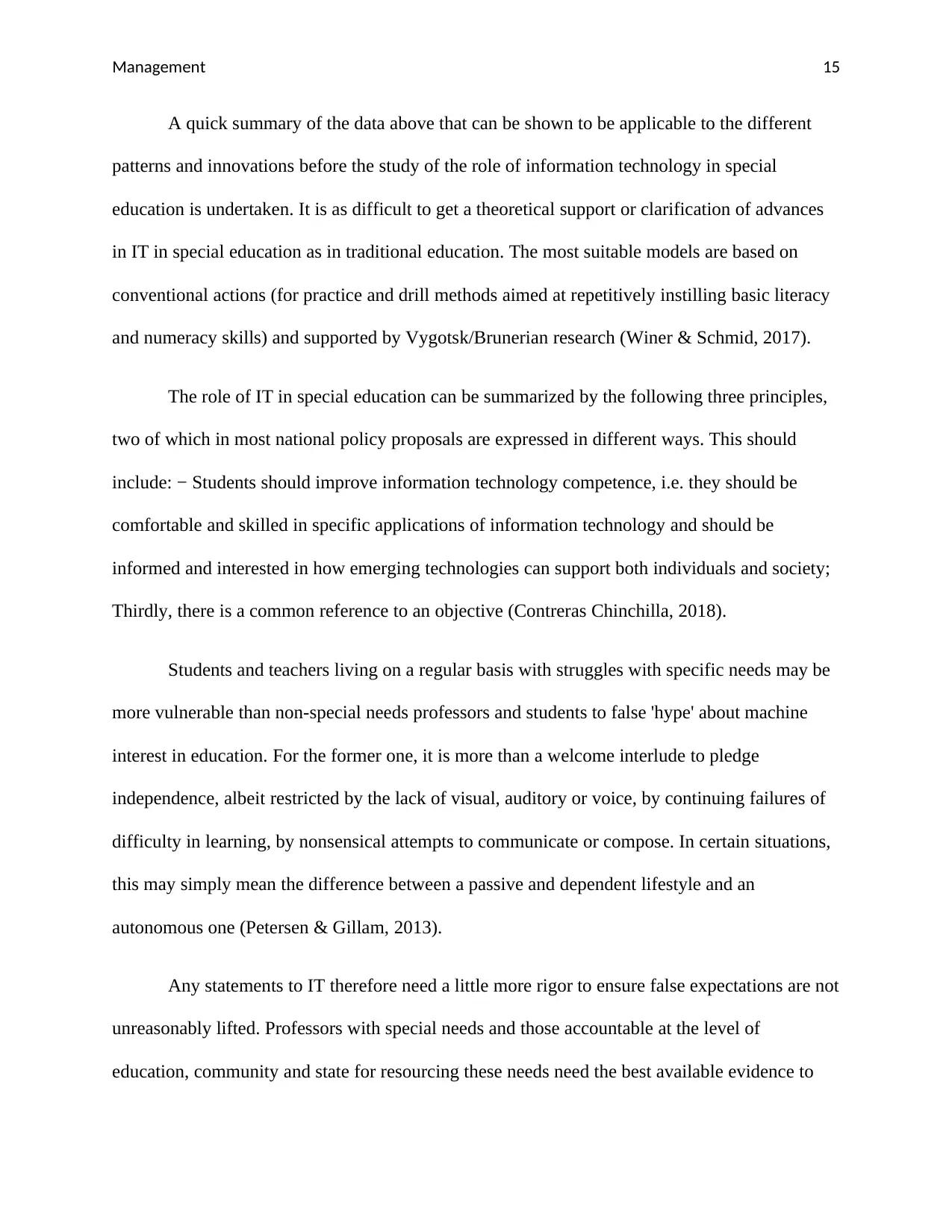
Management 15
A quick summary of the data above that can be shown to be applicable to the different
patterns and innovations before the study of the role of information technology in special
education is undertaken. It is as difficult to get a theoretical support or clarification of advances
in IT in special education as in traditional education. The most suitable models are based on
conventional actions (for practice and drill methods aimed at repetitively instilling basic literacy
and numeracy skills) and supported by Vygotsk/Brunerian research (Winer & Schmid, 2017).
The role of IT in special education can be summarized by the following three principles,
two of which in most national policy proposals are expressed in different ways. This should
include: − Students should improve information technology competence, i.e. they should be
comfortable and skilled in specific applications of information technology and should be
informed and interested in how emerging technologies can support both individuals and society;
Thirdly, there is a common reference to an objective (Contreras Chinchilla, 2018).
Students and teachers living on a regular basis with struggles with specific needs may be
more vulnerable than non-special needs professors and students to false 'hype' about machine
interest in education. For the former one, it is more than a welcome interlude to pledge
independence, albeit restricted by the lack of visual, auditory or voice, by continuing failures of
difficulty in learning, by nonsensical attempts to communicate or compose. In certain situations,
this may simply mean the difference between a passive and dependent lifestyle and an
autonomous one (Petersen & Gillam, 2013).
Any statements to IT therefore need a little more rigor to ensure false expectations are not
unreasonably lifted. Professors with special needs and those accountable at the level of
education, community and state for resourcing these needs need the best available evidence to
A quick summary of the data above that can be shown to be applicable to the different
patterns and innovations before the study of the role of information technology in special
education is undertaken. It is as difficult to get a theoretical support or clarification of advances
in IT in special education as in traditional education. The most suitable models are based on
conventional actions (for practice and drill methods aimed at repetitively instilling basic literacy
and numeracy skills) and supported by Vygotsk/Brunerian research (Winer & Schmid, 2017).
The role of IT in special education can be summarized by the following three principles,
two of which in most national policy proposals are expressed in different ways. This should
include: − Students should improve information technology competence, i.e. they should be
comfortable and skilled in specific applications of information technology and should be
informed and interested in how emerging technologies can support both individuals and society;
Thirdly, there is a common reference to an objective (Contreras Chinchilla, 2018).
Students and teachers living on a regular basis with struggles with specific needs may be
more vulnerable than non-special needs professors and students to false 'hype' about machine
interest in education. For the former one, it is more than a welcome interlude to pledge
independence, albeit restricted by the lack of visual, auditory or voice, by continuing failures of
difficulty in learning, by nonsensical attempts to communicate or compose. In certain situations,
this may simply mean the difference between a passive and dependent lifestyle and an
autonomous one (Petersen & Gillam, 2013).
Any statements to IT therefore need a little more rigor to ensure false expectations are not
unreasonably lifted. Professors with special needs and those accountable at the level of
education, community and state for resourcing these needs need the best available evidence to
Secure Best Marks with AI Grader
Need help grading? Try our AI Grader for instant feedback on your assignments.
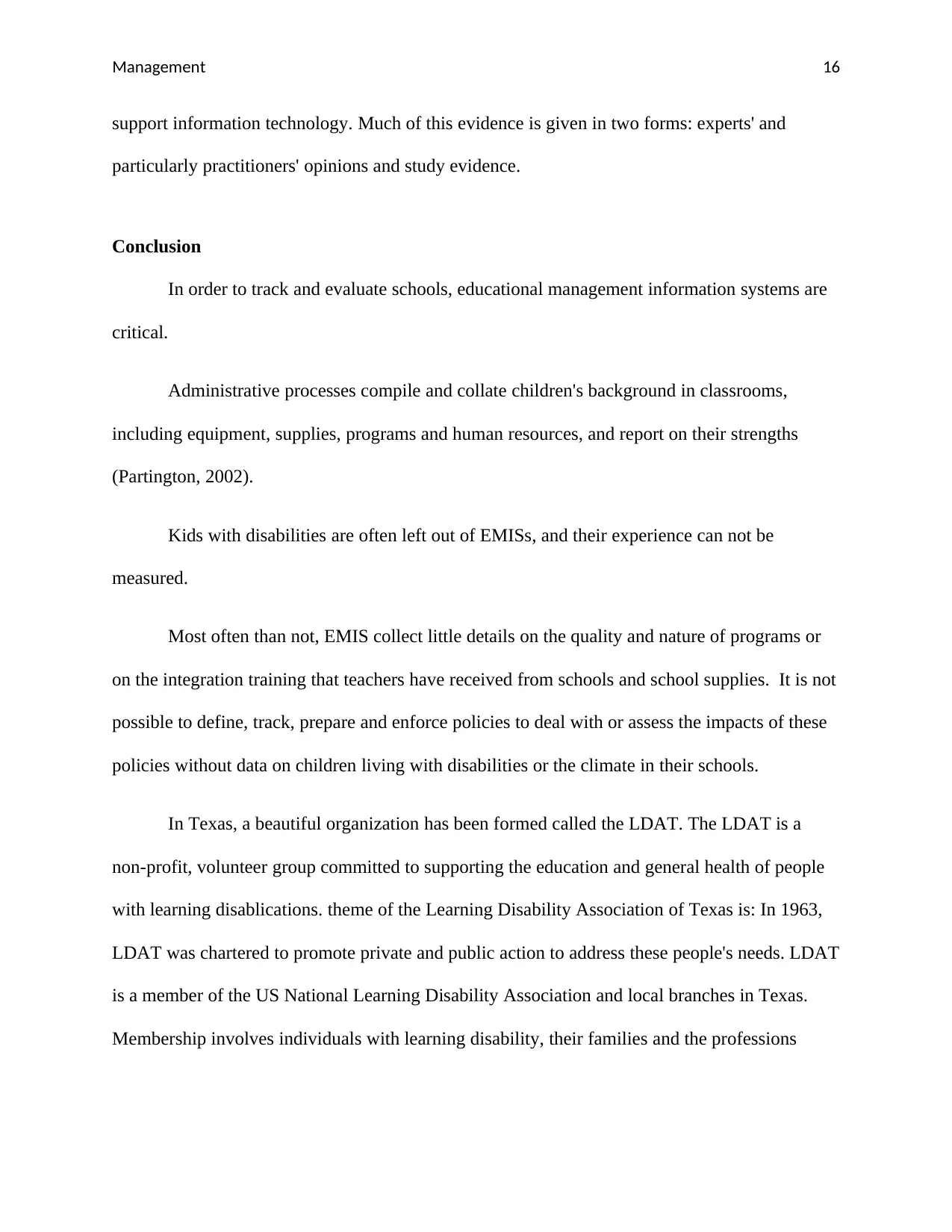
Management 16
support information technology. Much of this evidence is given in two forms: experts' and
particularly practitioners' opinions and study evidence.
Conclusion
In order to track and evaluate schools, educational management information systems are
critical.
Administrative processes compile and collate children's background in classrooms,
including equipment, supplies, programs and human resources, and report on their strengths
(Partington, 2002).
Kids with disabilities are often left out of EMISs, and their experience can not be
measured.
Most often than not, EMIS collect little details on the quality and nature of programs or
on the integration training that teachers have received from schools and school supplies. It is not
possible to define, track, prepare and enforce policies to deal with or assess the impacts of these
policies without data on children living with disabilities or the climate in their schools.
In Texas, a beautiful organization has been formed called the LDAT. The LDAT is a
non-profit, volunteer group committed to supporting the education and general health of people
with learning disablications. theme of the Learning Disability Association of Texas is: In 1963,
LDAT was chartered to promote private and public action to address these people's needs. LDAT
is a member of the US National Learning Disability Association and local branches in Texas.
Membership involves individuals with learning disability, their families and the professions
support information technology. Much of this evidence is given in two forms: experts' and
particularly practitioners' opinions and study evidence.
Conclusion
In order to track and evaluate schools, educational management information systems are
critical.
Administrative processes compile and collate children's background in classrooms,
including equipment, supplies, programs and human resources, and report on their strengths
(Partington, 2002).
Kids with disabilities are often left out of EMISs, and their experience can not be
measured.
Most often than not, EMIS collect little details on the quality and nature of programs or
on the integration training that teachers have received from schools and school supplies. It is not
possible to define, track, prepare and enforce policies to deal with or assess the impacts of these
policies without data on children living with disabilities or the climate in their schools.
In Texas, a beautiful organization has been formed called the LDAT. The LDAT is a
non-profit, volunteer group committed to supporting the education and general health of people
with learning disablications. theme of the Learning Disability Association of Texas is: In 1963,
LDAT was chartered to promote private and public action to address these people's needs. LDAT
is a member of the US National Learning Disability Association and local branches in Texas.
Membership involves individuals with learning disability, their families and the professions
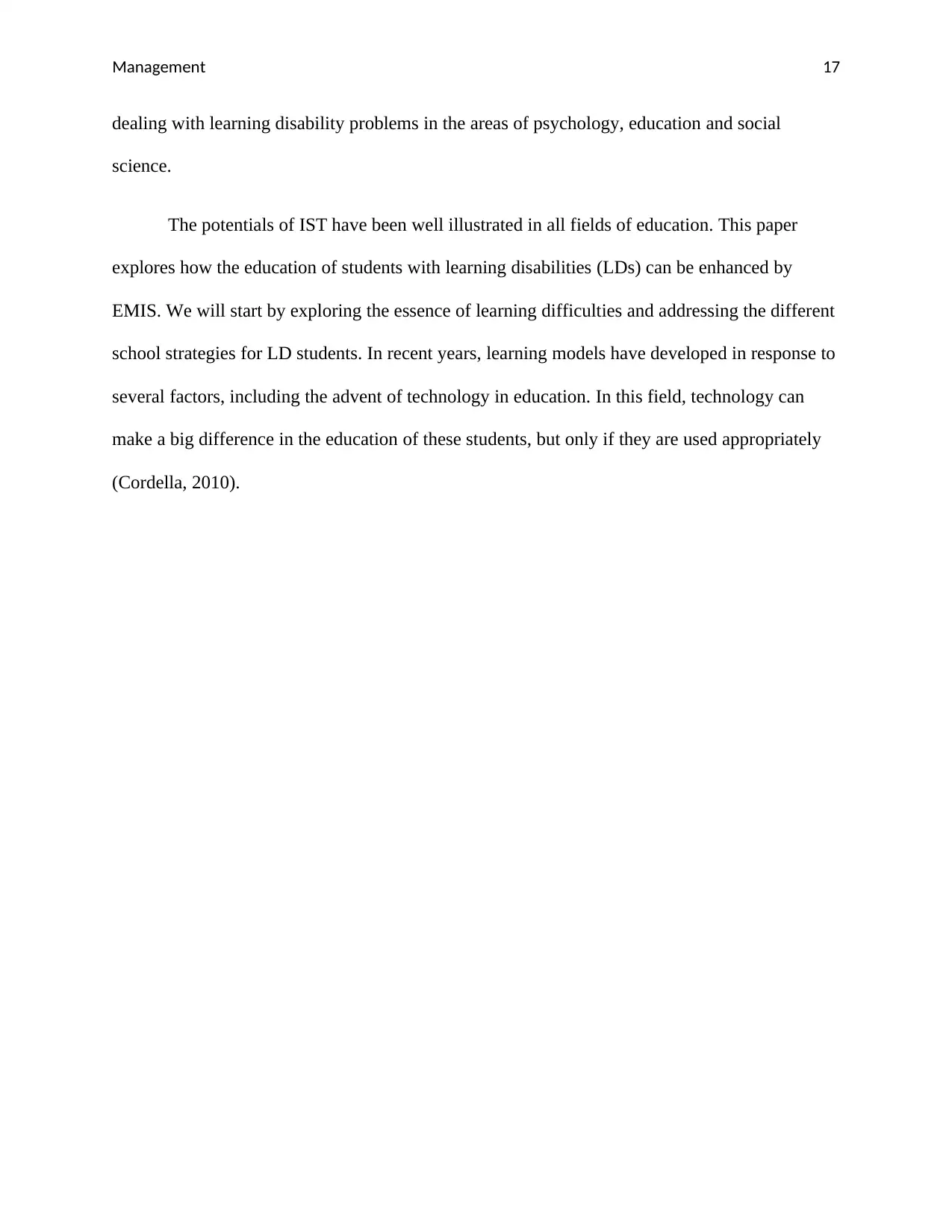
Management 17
dealing with learning disability problems in the areas of psychology, education and social
science.
The potentials of IST have been well illustrated in all fields of education. This paper
explores how the education of students with learning disabilities (LDs) can be enhanced by
EMIS. We will start by exploring the essence of learning difficulties and addressing the different
school strategies for LD students. In recent years, learning models have developed in response to
several factors, including the advent of technology in education. In this field, technology can
make a big difference in the education of these students, but only if they are used appropriately
(Cordella, 2010).
dealing with learning disability problems in the areas of psychology, education and social
science.
The potentials of IST have been well illustrated in all fields of education. This paper
explores how the education of students with learning disabilities (LDs) can be enhanced by
EMIS. We will start by exploring the essence of learning difficulties and addressing the different
school strategies for LD students. In recent years, learning models have developed in response to
several factors, including the advent of technology in education. In this field, technology can
make a big difference in the education of these students, but only if they are used appropriately
(Cordella, 2010).
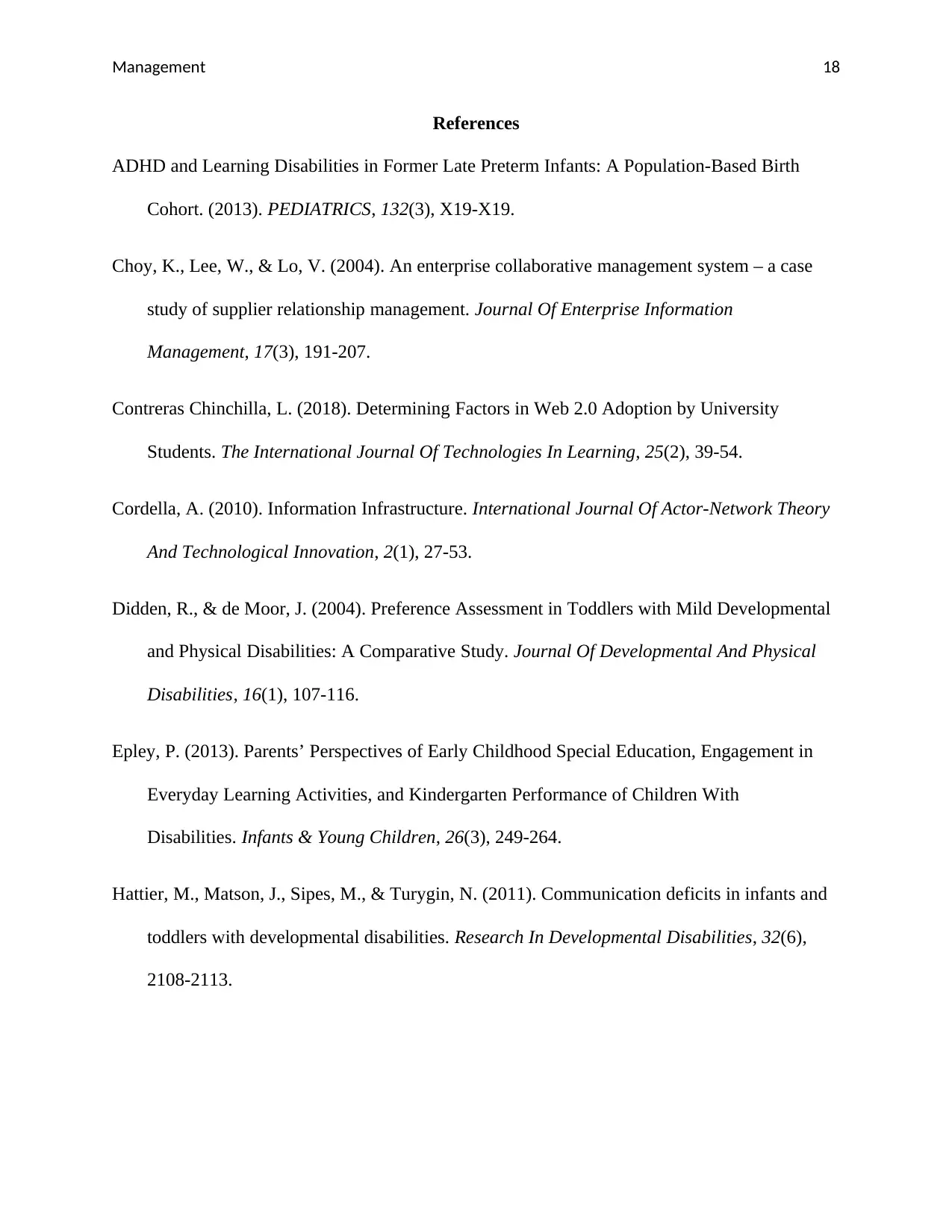
Management 18
References
ADHD and Learning Disabilities in Former Late Preterm Infants: A Population-Based Birth
Cohort. (2013). PEDIATRICS, 132(3), X19-X19.
Choy, K., Lee, W., & Lo, V. (2004). An enterprise collaborative management system – a case
study of supplier relationship management. Journal Of Enterprise Information
Management, 17(3), 191-207.
Contreras Chinchilla, L. (2018). Determining Factors in Web 2.0 Adoption by University
Students. The International Journal Of Technologies In Learning, 25(2), 39-54.
Cordella, A. (2010). Information Infrastructure. International Journal Of Actor-Network Theory
And Technological Innovation, 2(1), 27-53.
Didden, R., & de Moor, J. (2004). Preference Assessment in Toddlers with Mild Developmental
and Physical Disabilities: A Comparative Study. Journal Of Developmental And Physical
Disabilities, 16(1), 107-116.
Epley, P. (2013). Parentsʼ Perspectives of Early Childhood Special Education, Engagement in
Everyday Learning Activities, and Kindergarten Performance of Children With
Disabilities. Infants & Young Children, 26(3), 249-264.
Hattier, M., Matson, J., Sipes, M., & Turygin, N. (2011). Communication deficits in infants and
toddlers with developmental disabilities. Research In Developmental Disabilities, 32(6),
2108-2113.
References
ADHD and Learning Disabilities in Former Late Preterm Infants: A Population-Based Birth
Cohort. (2013). PEDIATRICS, 132(3), X19-X19.
Choy, K., Lee, W., & Lo, V. (2004). An enterprise collaborative management system – a case
study of supplier relationship management. Journal Of Enterprise Information
Management, 17(3), 191-207.
Contreras Chinchilla, L. (2018). Determining Factors in Web 2.0 Adoption by University
Students. The International Journal Of Technologies In Learning, 25(2), 39-54.
Cordella, A. (2010). Information Infrastructure. International Journal Of Actor-Network Theory
And Technological Innovation, 2(1), 27-53.
Didden, R., & de Moor, J. (2004). Preference Assessment in Toddlers with Mild Developmental
and Physical Disabilities: A Comparative Study. Journal Of Developmental And Physical
Disabilities, 16(1), 107-116.
Epley, P. (2013). Parentsʼ Perspectives of Early Childhood Special Education, Engagement in
Everyday Learning Activities, and Kindergarten Performance of Children With
Disabilities. Infants & Young Children, 26(3), 249-264.
Hattier, M., Matson, J., Sipes, M., & Turygin, N. (2011). Communication deficits in infants and
toddlers with developmental disabilities. Research In Developmental Disabilities, 32(6),
2108-2113.
Paraphrase This Document
Need a fresh take? Get an instant paraphrase of this document with our AI Paraphraser
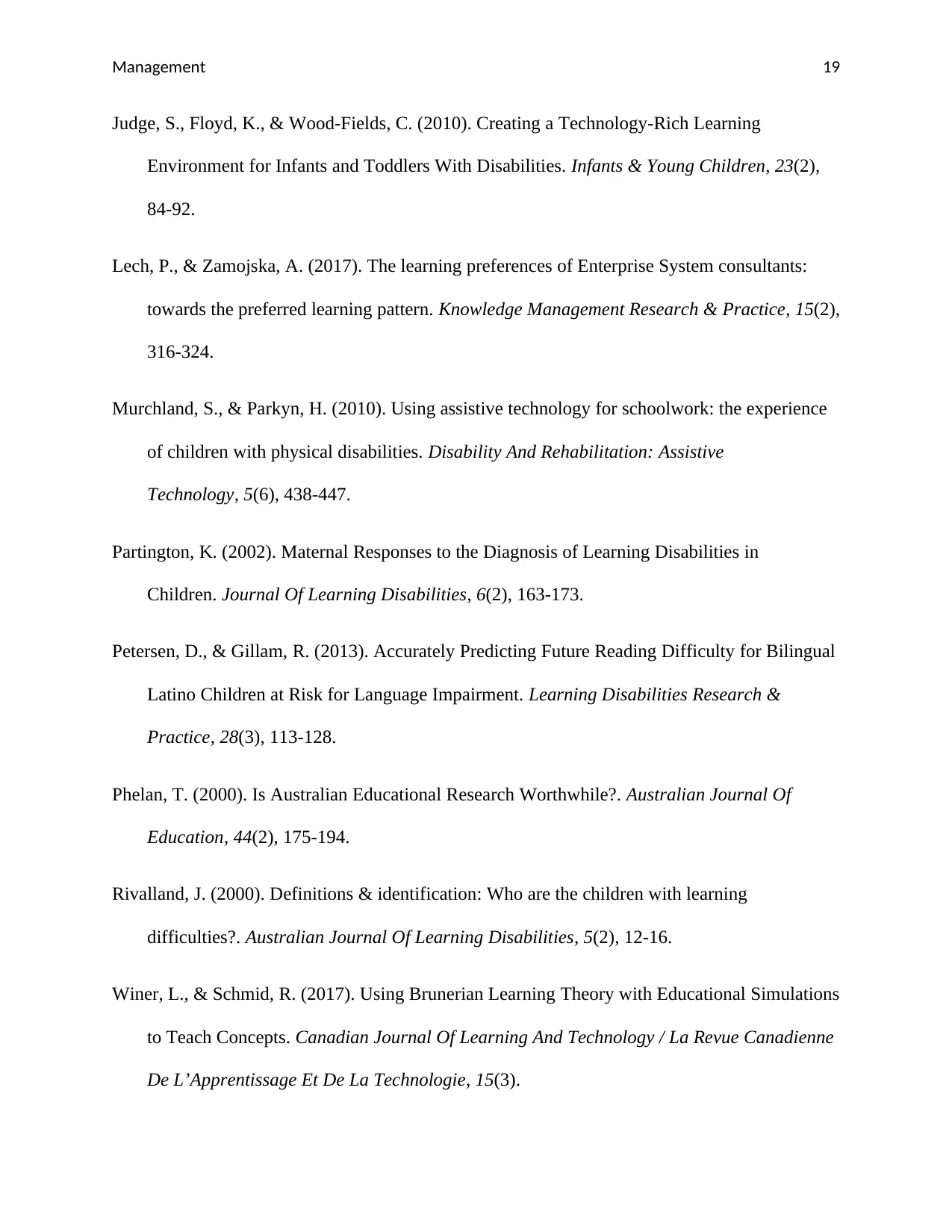
Management 19
Judge, S., Floyd, K., & Wood-Fields, C. (2010). Creating a Technology-Rich Learning
Environment for Infants and Toddlers With Disabilities. Infants & Young Children, 23(2),
84-92.
Lech, P., & Zamojska, A. (2017). The learning preferences of Enterprise System consultants:
towards the preferred learning pattern. Knowledge Management Research & Practice, 15(2),
316-324.
Murchland, S., & Parkyn, H. (2010). Using assistive technology for schoolwork: the experience
of children with physical disabilities. Disability And Rehabilitation: Assistive
Technology, 5(6), 438-447.
Partington, K. (2002). Maternal Responses to the Diagnosis of Learning Disabilities in
Children. Journal Of Learning Disabilities, 6(2), 163-173.
Petersen, D., & Gillam, R. (2013). Accurately Predicting Future Reading Difficulty for Bilingual
Latino Children at Risk for Language Impairment. Learning Disabilities Research &
Practice, 28(3), 113-128.
Phelan, T. (2000). Is Australian Educational Research Worthwhile?. Australian Journal Of
Education, 44(2), 175-194.
Rivalland, J. (2000). Definitions & identification: Who are the children with learning
difficulties?. Australian Journal Of Learning Disabilities, 5(2), 12-16.
Winer, L., & Schmid, R. (2017). Using Brunerian Learning Theory with Educational Simulations
to Teach Concepts. Canadian Journal Of Learning And Technology / La Revue Canadienne
De L’Apprentissage Et De La Technologie, 15(3).
Judge, S., Floyd, K., & Wood-Fields, C. (2010). Creating a Technology-Rich Learning
Environment for Infants and Toddlers With Disabilities. Infants & Young Children, 23(2),
84-92.
Lech, P., & Zamojska, A. (2017). The learning preferences of Enterprise System consultants:
towards the preferred learning pattern. Knowledge Management Research & Practice, 15(2),
316-324.
Murchland, S., & Parkyn, H. (2010). Using assistive technology for schoolwork: the experience
of children with physical disabilities. Disability And Rehabilitation: Assistive
Technology, 5(6), 438-447.
Partington, K. (2002). Maternal Responses to the Diagnosis of Learning Disabilities in
Children. Journal Of Learning Disabilities, 6(2), 163-173.
Petersen, D., & Gillam, R. (2013). Accurately Predicting Future Reading Difficulty for Bilingual
Latino Children at Risk for Language Impairment. Learning Disabilities Research &
Practice, 28(3), 113-128.
Phelan, T. (2000). Is Australian Educational Research Worthwhile?. Australian Journal Of
Education, 44(2), 175-194.
Rivalland, J. (2000). Definitions & identification: Who are the children with learning
difficulties?. Australian Journal Of Learning Disabilities, 5(2), 12-16.
Winer, L., & Schmid, R. (2017). Using Brunerian Learning Theory with Educational Simulations
to Teach Concepts. Canadian Journal Of Learning And Technology / La Revue Canadienne
De L’Apprentissage Et De La Technologie, 15(3).
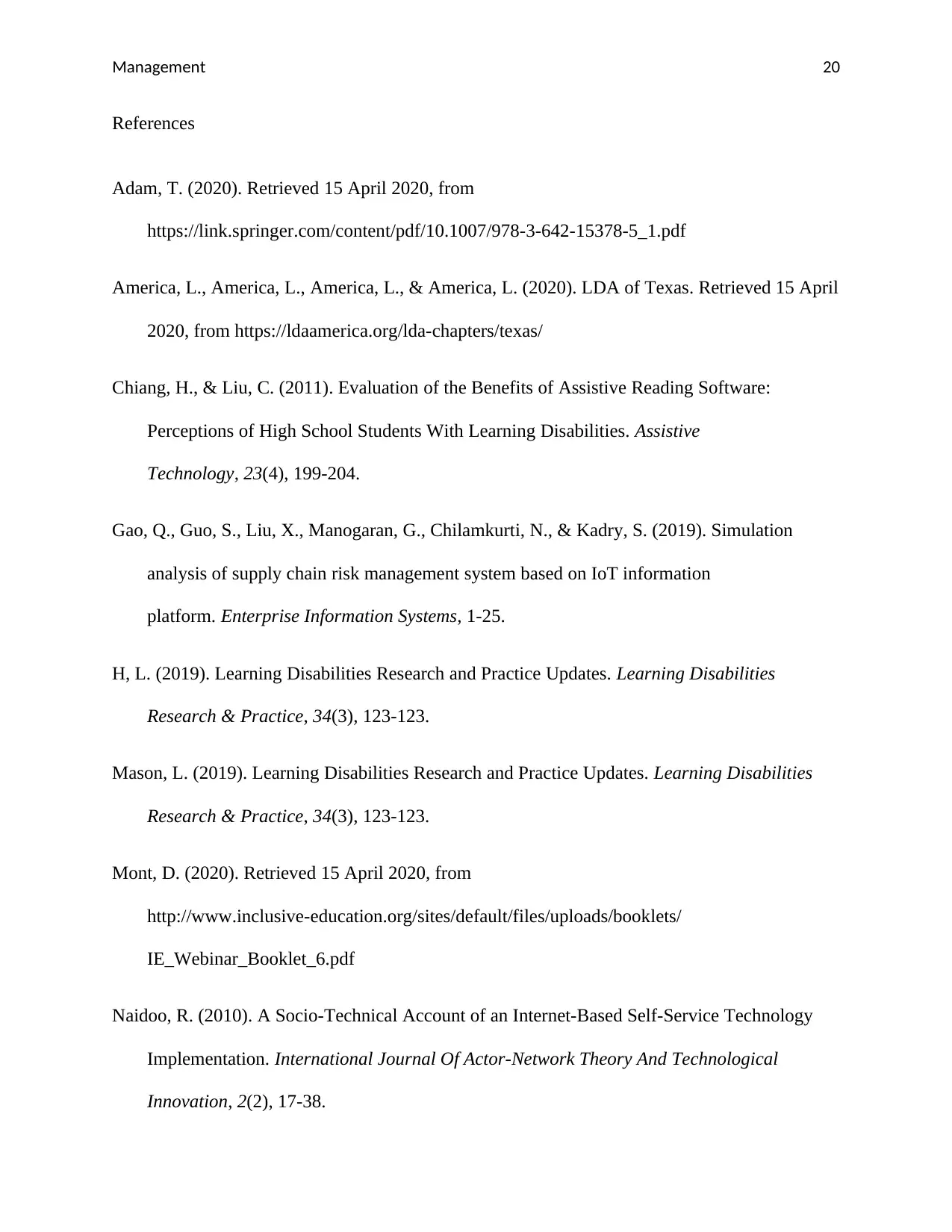
Management 20
References
Adam, T. (2020). Retrieved 15 April 2020, from
https://link.springer.com/content/pdf/10.1007/978-3-642-15378-5_1.pdf
America, L., America, L., America, L., & America, L. (2020). LDA of Texas. Retrieved 15 April
2020, from https://ldaamerica.org/lda-chapters/texas/
Chiang, H., & Liu, C. (2011). Evaluation of the Benefits of Assistive Reading Software:
Perceptions of High School Students With Learning Disabilities. Assistive
Technology, 23(4), 199-204.
Gao, Q., Guo, S., Liu, X., Manogaran, G., Chilamkurti, N., & Kadry, S. (2019). Simulation
analysis of supply chain risk management system based on IoT information
platform. Enterprise Information Systems, 1-25.
H, L. (2019). Learning Disabilities Research and Practice Updates. Learning Disabilities
Research & Practice, 34(3), 123-123.
Mason, L. (2019). Learning Disabilities Research and Practice Updates. Learning Disabilities
Research & Practice, 34(3), 123-123.
Mont, D. (2020). Retrieved 15 April 2020, from
http://www.inclusive-education.org/sites/default/files/uploads/booklets/
IE_Webinar_Booklet_6.pdf
Naidoo, R. (2010). A Socio-Technical Account of an Internet-Based Self-Service Technology
Implementation. International Journal Of Actor-Network Theory And Technological
Innovation, 2(2), 17-38.
References
Adam, T. (2020). Retrieved 15 April 2020, from
https://link.springer.com/content/pdf/10.1007/978-3-642-15378-5_1.pdf
America, L., America, L., America, L., & America, L. (2020). LDA of Texas. Retrieved 15 April
2020, from https://ldaamerica.org/lda-chapters/texas/
Chiang, H., & Liu, C. (2011). Evaluation of the Benefits of Assistive Reading Software:
Perceptions of High School Students With Learning Disabilities. Assistive
Technology, 23(4), 199-204.
Gao, Q., Guo, S., Liu, X., Manogaran, G., Chilamkurti, N., & Kadry, S. (2019). Simulation
analysis of supply chain risk management system based on IoT information
platform. Enterprise Information Systems, 1-25.
H, L. (2019). Learning Disabilities Research and Practice Updates. Learning Disabilities
Research & Practice, 34(3), 123-123.
Mason, L. (2019). Learning Disabilities Research and Practice Updates. Learning Disabilities
Research & Practice, 34(3), 123-123.
Mont, D. (2020). Retrieved 15 April 2020, from
http://www.inclusive-education.org/sites/default/files/uploads/booklets/
IE_Webinar_Booklet_6.pdf
Naidoo, R. (2010). A Socio-Technical Account of an Internet-Based Self-Service Technology
Implementation. International Journal Of Actor-Network Theory And Technological
Innovation, 2(2), 17-38.
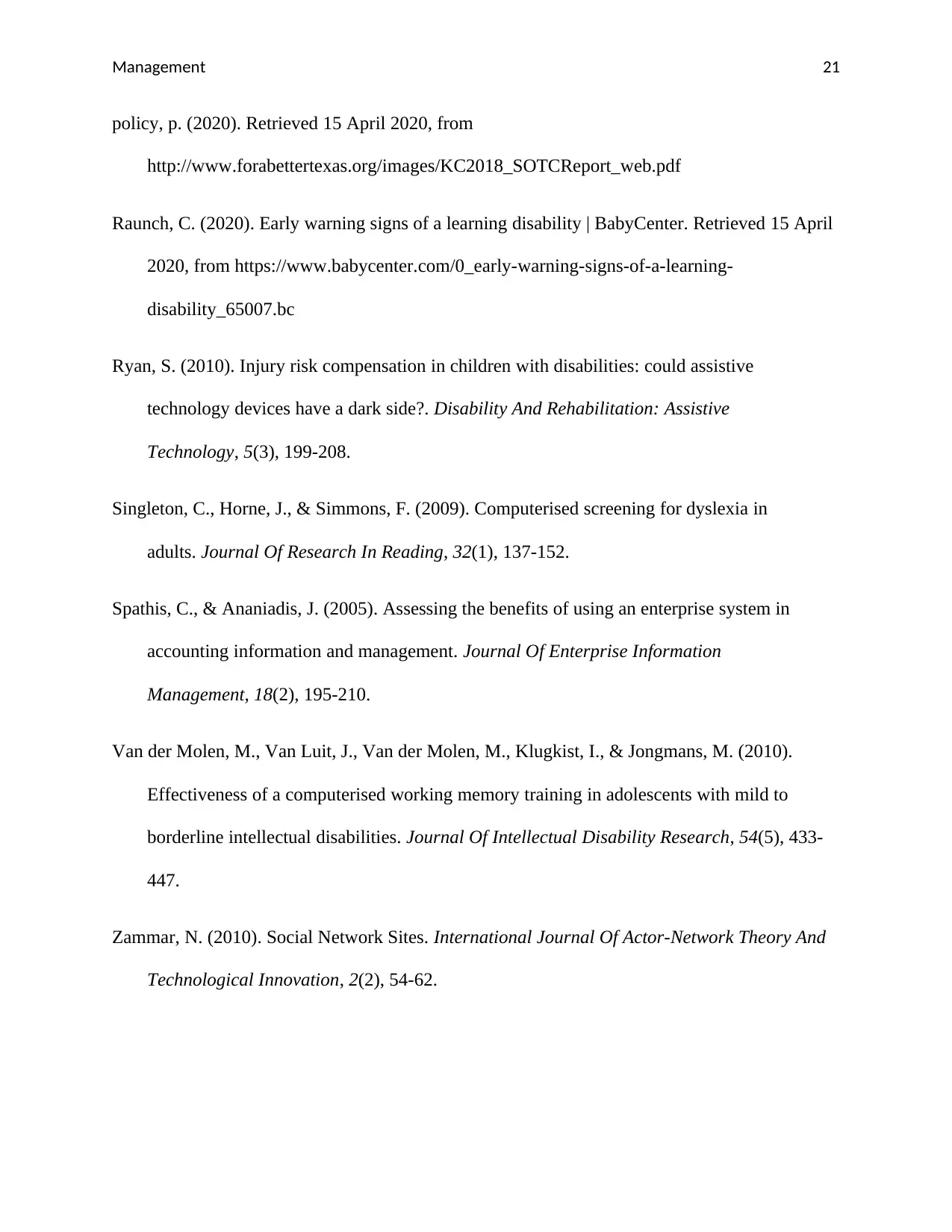
Management 21
policy, p. (2020). Retrieved 15 April 2020, from
http://www.forabettertexas.org/images/KC2018_SOTCReport_web.pdf
Raunch, C. (2020). Early warning signs of a learning disability | BabyCenter. Retrieved 15 April
2020, from https://www.babycenter.com/0_early-warning-signs-of-a-learning-
disability_65007.bc
Ryan, S. (2010). Injury risk compensation in children with disabilities: could assistive
technology devices have a dark side?. Disability And Rehabilitation: Assistive
Technology, 5(3), 199-208.
Singleton, C., Horne, J., & Simmons, F. (2009). Computerised screening for dyslexia in
adults. Journal Of Research In Reading, 32(1), 137-152.
Spathis, C., & Ananiadis, J. (2005). Assessing the benefits of using an enterprise system in
accounting information and management. Journal Of Enterprise Information
Management, 18(2), 195-210.
Van der Molen, M., Van Luit, J., Van der Molen, M., Klugkist, I., & Jongmans, M. (2010).
Effectiveness of a computerised working memory training in adolescents with mild to
borderline intellectual disabilities. Journal Of Intellectual Disability Research, 54(5), 433-
447.
Zammar, N. (2010). Social Network Sites. International Journal Of Actor-Network Theory And
Technological Innovation, 2(2), 54-62.
policy, p. (2020). Retrieved 15 April 2020, from
http://www.forabettertexas.org/images/KC2018_SOTCReport_web.pdf
Raunch, C. (2020). Early warning signs of a learning disability | BabyCenter. Retrieved 15 April
2020, from https://www.babycenter.com/0_early-warning-signs-of-a-learning-
disability_65007.bc
Ryan, S. (2010). Injury risk compensation in children with disabilities: could assistive
technology devices have a dark side?. Disability And Rehabilitation: Assistive
Technology, 5(3), 199-208.
Singleton, C., Horne, J., & Simmons, F. (2009). Computerised screening for dyslexia in
adults. Journal Of Research In Reading, 32(1), 137-152.
Spathis, C., & Ananiadis, J. (2005). Assessing the benefits of using an enterprise system in
accounting information and management. Journal Of Enterprise Information
Management, 18(2), 195-210.
Van der Molen, M., Van Luit, J., Van der Molen, M., Klugkist, I., & Jongmans, M. (2010).
Effectiveness of a computerised working memory training in adolescents with mild to
borderline intellectual disabilities. Journal Of Intellectual Disability Research, 54(5), 433-
447.
Zammar, N. (2010). Social Network Sites. International Journal Of Actor-Network Theory And
Technological Innovation, 2(2), 54-62.
Secure Best Marks with AI Grader
Need help grading? Try our AI Grader for instant feedback on your assignments.
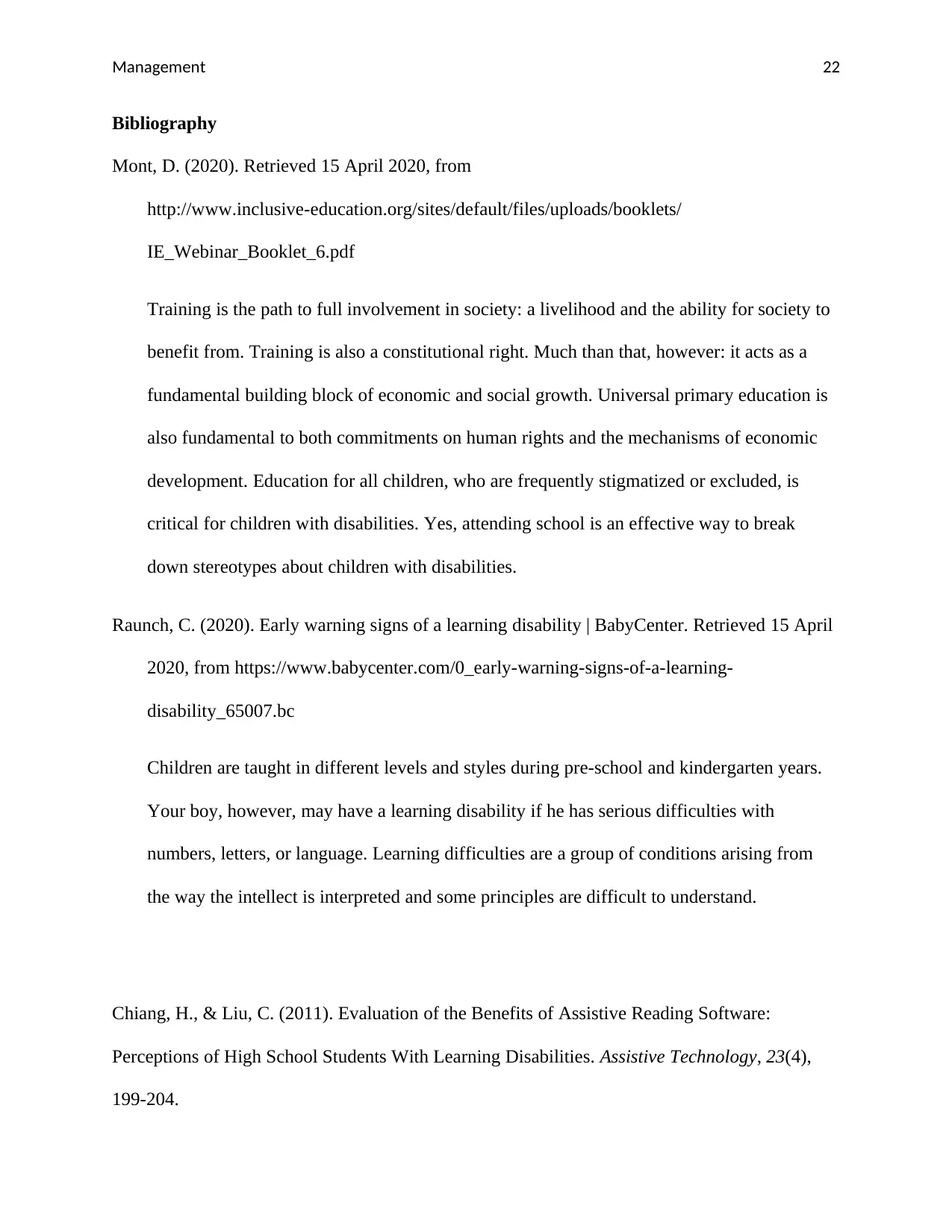
Management 22
Bibliography
Mont, D. (2020). Retrieved 15 April 2020, from
http://www.inclusive-education.org/sites/default/files/uploads/booklets/
IE_Webinar_Booklet_6.pdf
Training is the path to full involvement in society: a livelihood and the ability for society to
benefit from. Training is also a constitutional right. Much than that, however: it acts as a
fundamental building block of economic and social growth. Universal primary education is
also fundamental to both commitments on human rights and the mechanisms of economic
development. Education for all children, who are frequently stigmatized or excluded, is
critical for children with disabilities. Yes, attending school is an effective way to break
down stereotypes about children with disabilities.
Raunch, C. (2020). Early warning signs of a learning disability | BabyCenter. Retrieved 15 April
2020, from https://www.babycenter.com/0_early-warning-signs-of-a-learning-
disability_65007.bc
Children are taught in different levels and styles during pre-school and kindergarten years.
Your boy, however, may have a learning disability if he has serious difficulties with
numbers, letters, or language. Learning difficulties are a group of conditions arising from
the way the intellect is interpreted and some principles are difficult to understand.
Chiang, H., & Liu, C. (2011). Evaluation of the Benefits of Assistive Reading Software:
Perceptions of High School Students With Learning Disabilities. Assistive Technology, 23(4),
199-204.
Bibliography
Mont, D. (2020). Retrieved 15 April 2020, from
http://www.inclusive-education.org/sites/default/files/uploads/booklets/
IE_Webinar_Booklet_6.pdf
Training is the path to full involvement in society: a livelihood and the ability for society to
benefit from. Training is also a constitutional right. Much than that, however: it acts as a
fundamental building block of economic and social growth. Universal primary education is
also fundamental to both commitments on human rights and the mechanisms of economic
development. Education for all children, who are frequently stigmatized or excluded, is
critical for children with disabilities. Yes, attending school is an effective way to break
down stereotypes about children with disabilities.
Raunch, C. (2020). Early warning signs of a learning disability | BabyCenter. Retrieved 15 April
2020, from https://www.babycenter.com/0_early-warning-signs-of-a-learning-
disability_65007.bc
Children are taught in different levels and styles during pre-school and kindergarten years.
Your boy, however, may have a learning disability if he has serious difficulties with
numbers, letters, or language. Learning difficulties are a group of conditions arising from
the way the intellect is interpreted and some principles are difficult to understand.
Chiang, H., & Liu, C. (2011). Evaluation of the Benefits of Assistive Reading Software:
Perceptions of High School Students With Learning Disabilities. Assistive Technology, 23(4),
199-204.
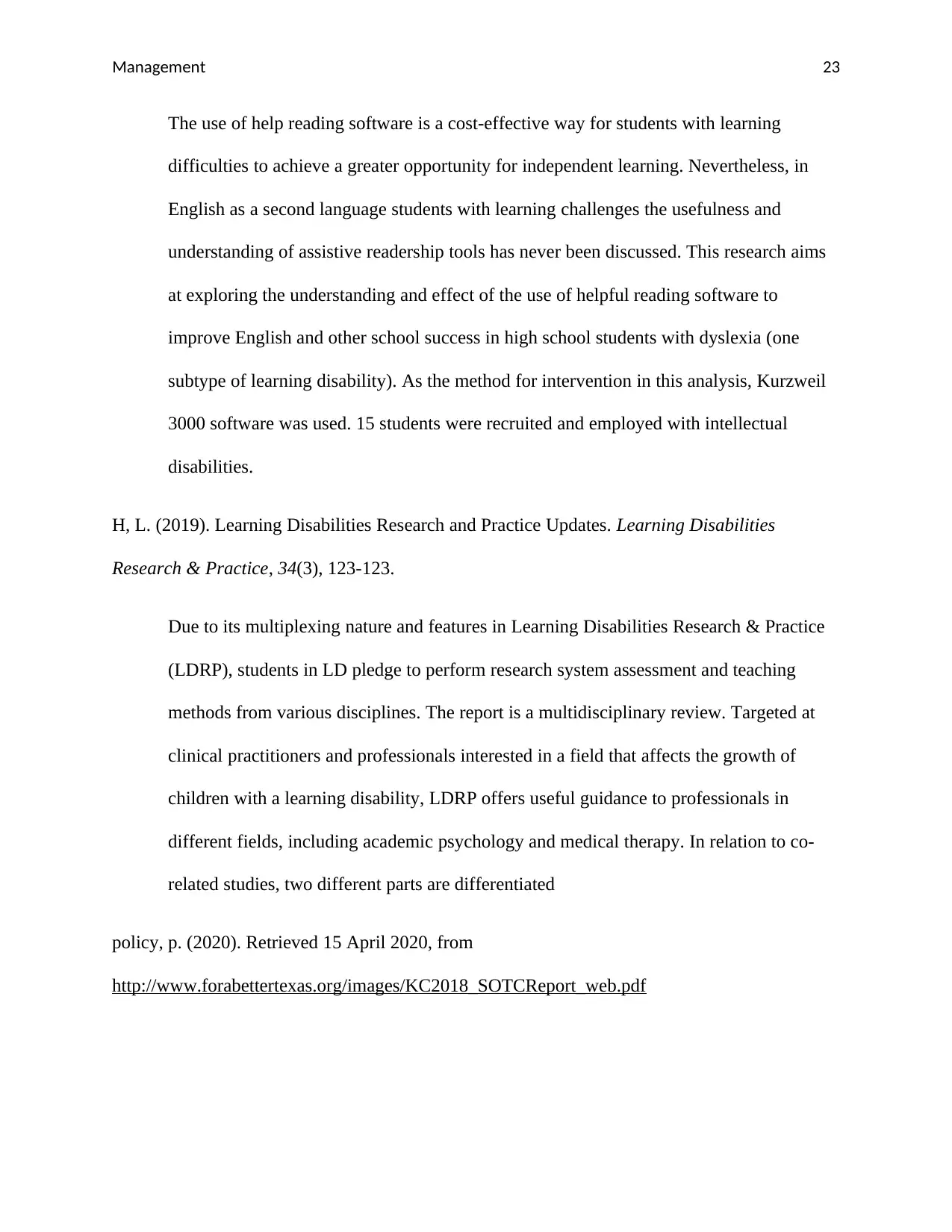
Management 23
The use of help reading software is a cost-effective way for students with learning
difficulties to achieve a greater opportunity for independent learning. Nevertheless, in
English as a second language students with learning challenges the usefulness and
understanding of assistive readership tools has never been discussed. This research aims
at exploring the understanding and effect of the use of helpful reading software to
improve English and other school success in high school students with dyslexia (one
subtype of learning disability). As the method for intervention in this analysis, Kurzweil
3000 software was used. 15 students were recruited and employed with intellectual
disabilities.
H, L. (2019). Learning Disabilities Research and Practice Updates. Learning Disabilities
Research & Practice, 34(3), 123-123.
Due to its multiplexing nature and features in Learning Disabilities Research & Practice
(LDRP), students in LD pledge to perform research system assessment and teaching
methods from various disciplines. The report is a multidisciplinary review. Targeted at
clinical practitioners and professionals interested in a field that affects the growth of
children with a learning disability, LDRP offers useful guidance to professionals in
different fields, including academic psychology and medical therapy. In relation to co-
related studies, two different parts are differentiated
policy, p. (2020). Retrieved 15 April 2020, from
http://www.forabettertexas.org/images/KC2018_SOTCReport_web.pdf
The use of help reading software is a cost-effective way for students with learning
difficulties to achieve a greater opportunity for independent learning. Nevertheless, in
English as a second language students with learning challenges the usefulness and
understanding of assistive readership tools has never been discussed. This research aims
at exploring the understanding and effect of the use of helpful reading software to
improve English and other school success in high school students with dyslexia (one
subtype of learning disability). As the method for intervention in this analysis, Kurzweil
3000 software was used. 15 students were recruited and employed with intellectual
disabilities.
H, L. (2019). Learning Disabilities Research and Practice Updates. Learning Disabilities
Research & Practice, 34(3), 123-123.
Due to its multiplexing nature and features in Learning Disabilities Research & Practice
(LDRP), students in LD pledge to perform research system assessment and teaching
methods from various disciplines. The report is a multidisciplinary review. Targeted at
clinical practitioners and professionals interested in a field that affects the growth of
children with a learning disability, LDRP offers useful guidance to professionals in
different fields, including academic psychology and medical therapy. In relation to co-
related studies, two different parts are differentiated
policy, p. (2020). Retrieved 15 April 2020, from
http://www.forabettertexas.org/images/KC2018_SOTCReport_web.pdf
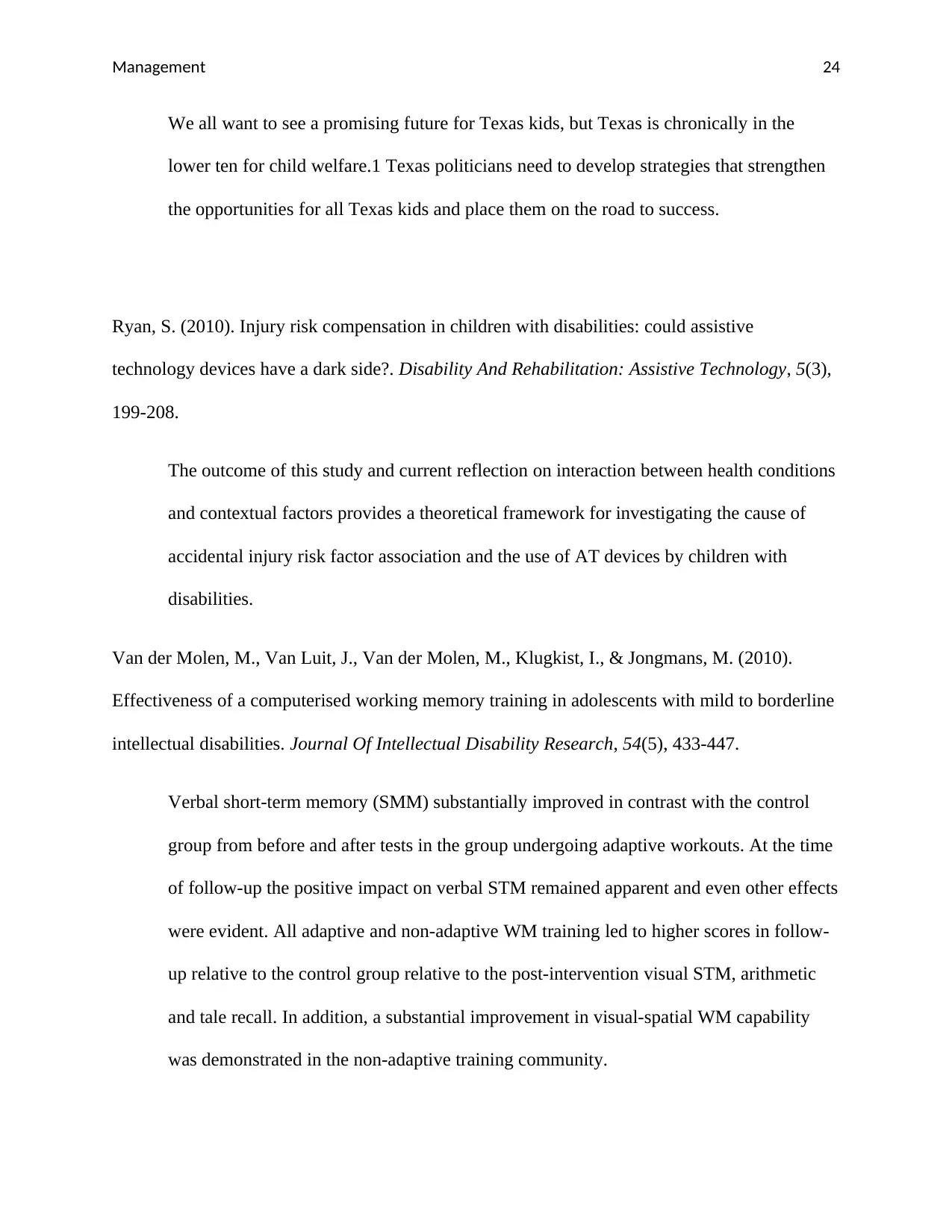
Management 24
We all want to see a promising future for Texas kids, but Texas is chronically in the
lower ten for child welfare.1 Texas politicians need to develop strategies that strengthen
the opportunities for all Texas kids and place them on the road to success.
Ryan, S. (2010). Injury risk compensation in children with disabilities: could assistive
technology devices have a dark side?. Disability And Rehabilitation: Assistive Technology, 5(3),
199-208.
The outcome of this study and current reflection on interaction between health conditions
and contextual factors provides a theoretical framework for investigating the cause of
accidental injury risk factor association and the use of AT devices by children with
disabilities.
Van der Molen, M., Van Luit, J., Van der Molen, M., Klugkist, I., & Jongmans, M. (2010).
Effectiveness of a computerised working memory training in adolescents with mild to borderline
intellectual disabilities. Journal Of Intellectual Disability Research, 54(5), 433-447.
Verbal short-term memory (SMM) substantially improved in contrast with the control
group from before and after tests in the group undergoing adaptive workouts. At the time
of follow-up the positive impact on verbal STM remained apparent and even other effects
were evident. All adaptive and non-adaptive WM training led to higher scores in follow-
up relative to the control group relative to the post-intervention visual STM, arithmetic
and tale recall. In addition, a substantial improvement in visual-spatial WM capability
was demonstrated in the non-adaptive training community.
We all want to see a promising future for Texas kids, but Texas is chronically in the
lower ten for child welfare.1 Texas politicians need to develop strategies that strengthen
the opportunities for all Texas kids and place them on the road to success.
Ryan, S. (2010). Injury risk compensation in children with disabilities: could assistive
technology devices have a dark side?. Disability And Rehabilitation: Assistive Technology, 5(3),
199-208.
The outcome of this study and current reflection on interaction between health conditions
and contextual factors provides a theoretical framework for investigating the cause of
accidental injury risk factor association and the use of AT devices by children with
disabilities.
Van der Molen, M., Van Luit, J., Van der Molen, M., Klugkist, I., & Jongmans, M. (2010).
Effectiveness of a computerised working memory training in adolescents with mild to borderline
intellectual disabilities. Journal Of Intellectual Disability Research, 54(5), 433-447.
Verbal short-term memory (SMM) substantially improved in contrast with the control
group from before and after tests in the group undergoing adaptive workouts. At the time
of follow-up the positive impact on verbal STM remained apparent and even other effects
were evident. All adaptive and non-adaptive WM training led to higher scores in follow-
up relative to the control group relative to the post-intervention visual STM, arithmetic
and tale recall. In addition, a substantial improvement in visual-spatial WM capability
was demonstrated in the non-adaptive training community.
1 out of 25
Related Documents
Your All-in-One AI-Powered Toolkit for Academic Success.
+13062052269
info@desklib.com
Available 24*7 on WhatsApp / Email
![[object Object]](/_next/static/media/star-bottom.7253800d.svg)
Unlock your academic potential
© 2024 | Zucol Services PVT LTD | All rights reserved.





